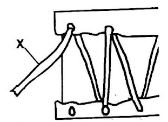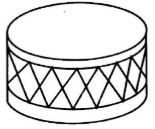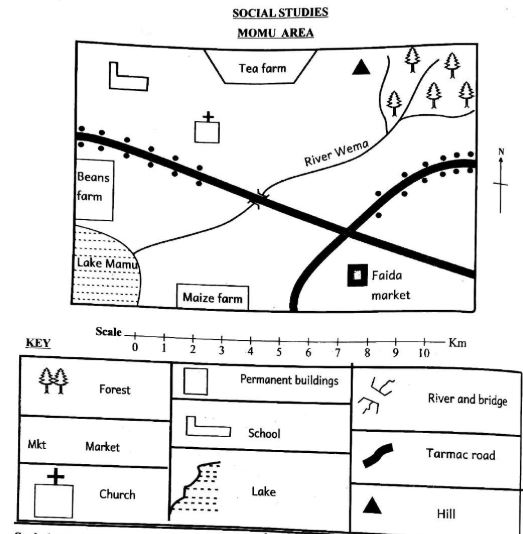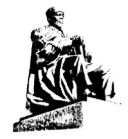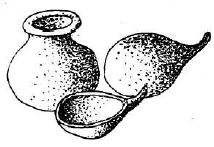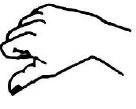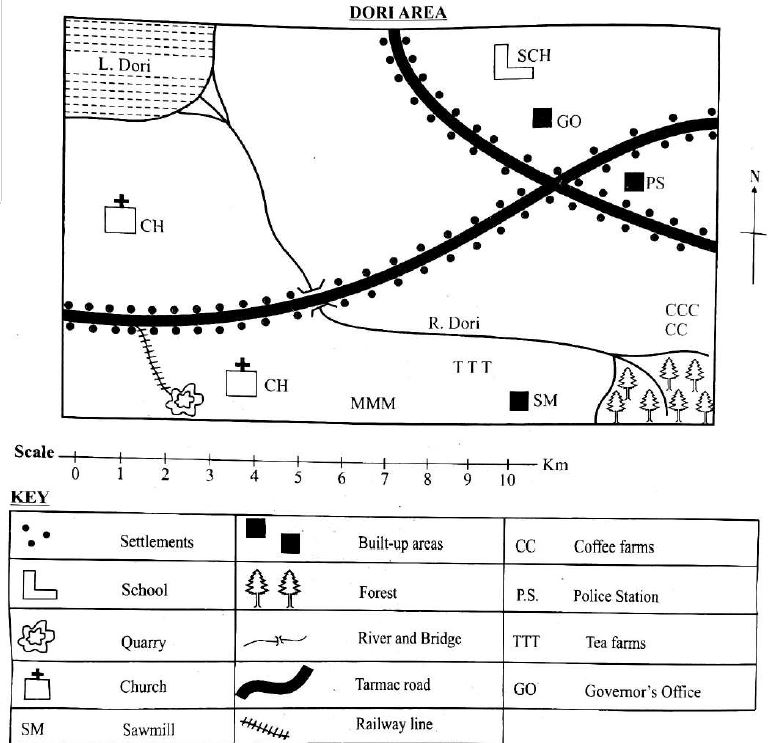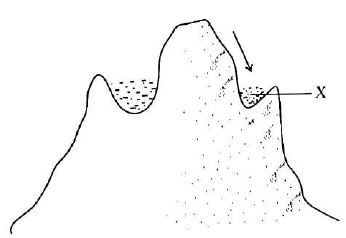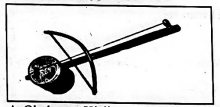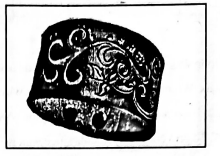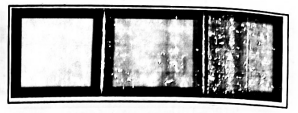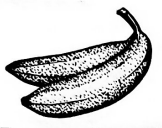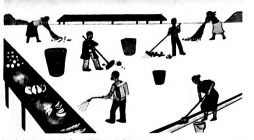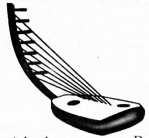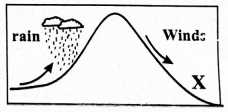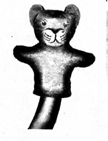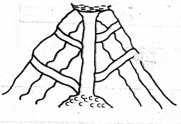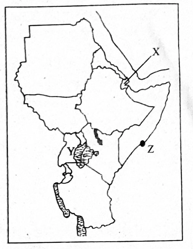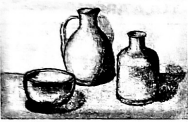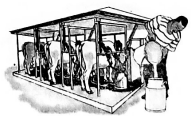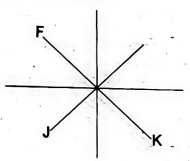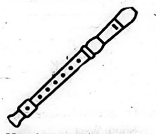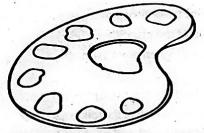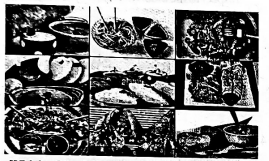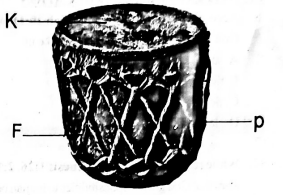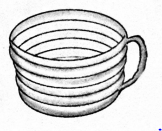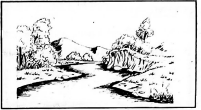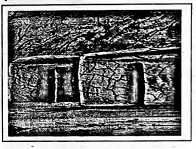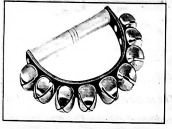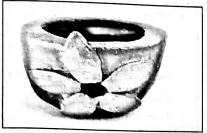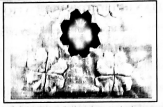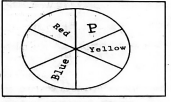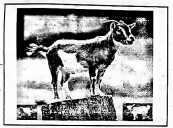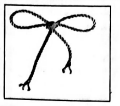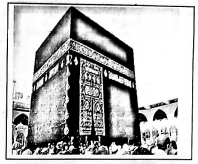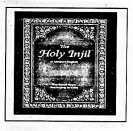Displaying items by tag: creative arts
Creative Arts & Social Studies Questions and Answers - Grade 4 End Term 2 Exams 2023 Set 1
ART AND CRAFT
- Grade 4 learners joined pieces of leather as shown below.
What is the name of the strip of leather labelled X?- Coil
- Thong
- Fibre
- Reeds
- Which of these items can be used to scratch waxy surface when creating pictures using crayon etching technique?
- Nail
- Eraser
- Paper
- Ruler
- Grade four learners of Kikuyu Township school modelled a pot using pinch technique. Which of the following is not a technique that the learners could have used to decorate the modelled pot?
- Stamping
- Scratching
- Kneading
- Incising
- The following materials are required when creating tonal variation on a cylindrical form. Which one is not?
- Pencil
- Sharpener
- Rubber
- Wax
- Learners modelled pots of varying sizes and shapes in class. How did they make the walls of the pinch pots to have even thickness?
- Using a stick to smoothen the pinch pot.
- Leaving the pot to dry slowly under a shade.
- Pressing against the walls using the thumb and fingers to widen the hole and shape the pot.
- Making a hole into the lump of clay using the thumb onlY
- Which of the following is a lower case letter?
- k
- t
- m
- g
- The following practices are usually carried by different communities when making baskets. Which one is not?
- Twining
- Plaiting
- Incising
- Sewing
- The following are natural materials that are used in basketry when weaving a circular mat. Which one is not?
- Nylon
- Banana fibre
- Reeds
- Wattle sticks
- Grade 4 learners created different pictorial composition using montage technique. Which locally available natural adhesive did they use to stick cut-out pictures and photographs?
- Glue sticks
- Office glue
- Cellotape
- Blue gum
- The following items are usually made from leather after the tanning process. Which one is not?
- Belts
- Bags
- Shoes
- Cups
- Grade 4 learners of Rungiri primary school were told to name different types of props that can be used in a folk dance. Among the answers given below, which one is not one of them?
- Flywhisk
- Sticks
- Shields
- Floor
- The following are safety measures that should be observed when dancing except one. Which one is it?
- Do not dance on a wet floor.
- Do not dance while wearing loose clothes and sharp costumes.
- Dance while stepping on others.
- Do not crowd together while dancing.
- Learners were taught the importance of cleaning a descant recorder before and after use. Why is it important to clean the instrument?
- To avoid using the descant recorder.
- To sell the descant recorder after use.
- To use the descant recorder many times in a day.
- To prevent the spread of germs and diseases.
- Learners were taught about groups of percussion instruments by their teacher. One of the instrument learnt was a drum shown below. What type of instrument is it?
- Melodic percussion instrument.
- Non-melodic percussion instrument.
- Wind instrument.
- String instrument.
- Re-arrange the following procedure in the correct order from the first step to the last step on how to make a functional shaker shown below.
- Flatten the bottle tops.
- Remove the inside soft part of the bottle tops.
- Make a hole in the middle of each bottle top.
- Put the bottle tops in a string or wire.
- Perform a song as you play the shaker.
- Tie the string or wire with the bottle tops to a Y-shaped stick.
- (ii), (i), (iv), (iii), (vi), (v)
- (ii), (i), (vi), (iii), (iv), (v)
- (ii), (i), (iii), (iv), (vi), (v)
- (i), (ii), (iii), (iv), (vi), (v)
- The following are values that we learn from folk songs. Which one is not?
- Kindness
- Unity
- Disobedience
- Peace
- Natalie named elements of dance. Which one was not correct?
- Resting
- Space
- Energy
- Time
- How do we call songs that are sung by people of a particular area or community to mark an occasion?
- Folk songs
- Sacred songs
- Topical songs
- Patriotic songs
- Samson wants to tune a drum. He can tune it by
- hitting it hard.
- warming the membrane.
- Couring cold water on it.
- sitting on it.
- The following are activities we can engage in when singing action songs. Which one is not?
- Sweeping
- Washing hands
- Fighting.
- Weaving mats
Study the map of Momu area and answer questions 21-25.
- Grade four learners were asked to identify the direction of the school from Faida market in Momu area. Which answer was correct?
- South West
- North West
- North East
- South East
- The church in Momu area shows that the people are
- Christians
- Muslims
- Pagans
- Hindus
- Which one of the following physical features is not found in Momu area?
- Hill
- Lake
- River
- Ocean
- Which of these crops is not grown in Momu area?
- Coffee
- Maize
- Tea
- Beans
- People of Momu area buy and sell their goods at the
- School
- Market
- Church
- Lake
- Kenya is divided into how many counties?
- 47
- 10
- 2
- 8
- The following are qualities of a good leader. Which one is not?
- Honest
- Responsible
- Corrupt
- Hardworking
- The sun rises from the
- East
- West
- North
- South
- Grade four Social Studies teacher asked grade four learners to state uses of rivers in their county. Which answer was wrong?
- Provide water for irrigation.
- Some rivers are sources of fish.
- Provide us with water for home use.
- They are homes for domestic animals.
- We all depend on doctors for
- treatment
- food
- education
- transport
- The following is a historical built environment. It is known as a
- museum
- monument
- cultural center
- school
- Identify a way of not caring for the environment?
- Cutting trees
- Planting trees
- Building of gabions
- Fencing forests
- Which one of the following is not a form of child abuse?
- Forcing children to go to school.
- Beating children.
- Denying children food.
- Employing children.
- The buying and selling of goods and services is known as
- farming
- trade
- transport
- communication
- Arrows, shields, horns, beads, spears and clay pots kept in a museum are called
- culture
- traditional artefacts
- monuments
- furniture
C.R.E
- "You created every part of me, you put me together in my mother's womb. (Psalms 139:13). This verse teaches us that
- God created all parts of our bodies.
- God created animals and plants.
- God did not know us before we were born.
- God does not love us the way we are.
- Select the letter which contains good emotion.
- Fear
- Sadness
- Anger
- Love
- In a Sunday School, grade four children told their teacher why they obey their parents as follows:
Martha - They give me food.
Titus - They do not curse me.
Dorcas - They pay my school fees.
Dan - So that I can live long on earth.
Who was correct according to Biblical teaching?- Martha
- Titus
- Dorcas
- Dan
- Ann returned the extra money she was given at a shop to the shopkeeper. Which value does she show?
- Love
- Honesty
- Kindness
- Obedience
- From the story of Samson killing a lion,, we learn to
- fear lions.
- depend on God's power.
- run away from danger.
- always walk in groups.
- We can protect ourselves from sexual abuse by
- walking alone in unsafe places.
- going into lonely rooms with people we do not know.
- not accepting gifts from strangers.
- meeting people of the opposite sex alone.
- God is pure and perfect. He cannot sin or make mistakes. This shows that God is
- Sole creator
- Holy
- Loving
- Kind
- Which group has Old Testament books of the Bible only?
- Luke, Acts, Genesis
- Psalms, Matthew, Jeremiah
- Exodus, Numbers, Nehemiah
- Judges, Romans, Proverbs
- teaching?
- The lesson learners can share with their parents after learning about the story of Zaccheaus is that they should
- climb a tree to see Jesus.
- turn away from bad behaviour.
- always invite people to their homes.
- hate people who do bad things.
- The name Abraham means
- saviour
- laughter
- father of many nations
- rock
- Jesus was called the son of God because
- his mother was a virgin.
- he was born by the power of the Holy Spirit.
- he was the only child of Joseph and Mary.
- he was given the name by the angel of God.
- Out of the ten lepers Jesus healed, only one of them went back to thank Him. A lesson we learn from this miracle is that we should be
- honest
- thankful
- caring
- respectful
- "The kingdom of God starts in a small way and grows to become bigger." This teaching is found in the parable of the
- lost coin
- lost son
- mustard seed
- sower
- One day, Brian was pushed by his friend when playing in the field. As a good Christian, Brian should
- also push his friend.
- go home and pray for his friend.
- forgive his friend.
- report his friend to the teacher.
- Pamela, a grade four learner was given 100 shillings by her mother. She can use her money wisely by
- buying sweets
- sharing the money with friends.
- buying a pen and saving the rest of the money.
- using the money to travel to a very far place.
I.R.E
- Three of the following are other names of Surah Al-Fatiha. Which one is not?
- The opening chapter.
- The third of the Qur'an.
- The mother of the Qur'an.
- The seven repeated verses.
- Which surah must be recited in every swalat?
- Al-Falaq
- Al-Maum
- An-Naas
- Al-Fatiha
- While playing in the school playground, Hanan picked a rubber in the grass. What was the right thing for Hanan to do?
- Keep the rubber for himself.
- Leave the rubber where it was.
- Take it to the class teacher.
- Report to the nearest police station.
- Which of the following books was revealed to Nabii Ibrahim (A.S.)?
- Suhuf
- . Zabur
- Taurat
- Qur'an
- Which one of the following surahs encourages patience among the Muslims?
- Asr
- BMaun
- Fiil
- Fatiha
- The actions and practices of the prophet (S.A.W) are referred to as
- Hadith
- Wajib
- Sunnah
- Mustahab
- Grade four learners of Kwashee primary school were asked to research online on the duties of the angels. Which of the following is not a duty of the angels?
- Bringing revelation.
- Beating those who commit sins.
- Recording our deeds.
- Bringing rainfall.
- Which one of the following is not a pillar of Iman? Belief in
- prophets
- angels
- day of judgement
- zakat
- Hashim, a grade four learner heard his friend saying. "Maashallah." What do you think Hashim's friend had seen?
- Something good.
- Something bad.
- A dangerous animal.
- A very old woman.
- All prophets of Allah were 'Masumeen.' This means that they were
- patient
- obedient
- sinless
- trustworthy
- Mama Hawa was seen sprinkling water on her clothes. Which type of Najasaat is likely to have gone to her dress?
- Medium
- Light
- Thick
- Heavy
- The angels of Allah were created from
- water
- dust
- fire
- light
- Which direction do Muslims face while performing prayers?
- North
- East
- South
- West
- Who among the following was the first man to be created?
- Ibrahim
- Adam
- Muhammad
- Nuh
- Choose the prayer that is correctly matched with its time.
- Dhuhr - 5.30a.m.
- Asr - 1 o'clock
- Subh - 5.30a.m.
- Isha - 6.30p.m.
MARKING SCHEME
ART
- B
- A
- C
- D
- C
- D
- C
- A
- D
- D
MUSIC
- D
- C
- D
- B
- C
- C
- A
- A
- B
- C
SOCIAL
- B
- A
- D
- A
- B
- A
- C
- A
- D
- A
- B
- A
- A
- B
- B
C.R.E
- A
- D
- D
- B
- B
- C
- B
- C
- B
- C
- B
- B
- C
- C
- C
I.R.E
- B
- D
- C
- A
- A
- C
- B
- D
- A
- C
- B
- D
- A
- B
- C
Creative Arts and Social Studies Questions and Answers - Grade 6 End Term Exams Term 2 2023 Set 1
ART AND CRAFT
- The following are different ways of preparing materials used to make items using the coil and stitch technique. Which one is not?
- Dyeing
- Plaiting
- Tearing
- Stitching
- The following are different ways that are used to create centre of interest in painting except one. Which one is it?
- Placing an object at the centre of the painting.
- Using colours that contrast.
- Tinting and shading an object.
- Making a particular object in the painting bigger than the rest.
- Abigael created the picture form below.
Which technique was used?- Cross-hatching technique
- Stippling technique
- Smudging technique
- Matting technique
- Anita designed a book jacket that was meant to protect the cover and the binding of a book to make it look beautiful. Which of the following answers is not part of a book jacket?
- Back page
- The spine
- The flaps
- The illustrations
- Grade 6 learners of Hekima school drew and decorated different 3D items using different techniques. The following are the techniques used in the decorations of the items except one. Which one?
- Cross hatching
- B. Smudging
- Embossing
- Stippling
- The following are elements of photography that are supposed to be observed while taking pictures. Which one is not an element of photography?
- Focus
- Image quality
- Composition
- View point
- There are different ways of making patterns on a piece of fabric to make tie and dye patterns. Abdi listed on the following ways. Which one is not one of the ways used?
- Knotting
- Incising
- Tying objects
- Folding
- Which of the following is a conventional surface for mounting 2D artwork?
- Hessian
- Canvas
- Plastic
- Paper
- Gabriella mixed colours to paint a colour wheel. Which colour did he get after mixing red and orange?
- Pink
- Purple
- Green
- Red Orange
- Who is a marionettist in the field of Art?
- A string used by a marionette.
- A puppet moving in different directiors.
- A person controlling the marionette.
- A type of puppet made to represent human or animal character.
MUSIC
- Grade six learners of Jivunia primary school learnt about different types of musical instruments and their specific communities. Which among the following instruments was wrongly matched with its community?
- Orutu - Luo
- Obokano - Abagusii
- Uta wa Wathi - Mijikenda
- Adeudeu - Iteso
- A grade six learner made a flute. The flute produced sound by
- bowing
- plucking
- hitting
- blowing
- During music lesson, learners listed down aspects of folk songs. Which one was not correct?
- Participants
- Instrumentation
- Messages
- Response
- What is the French rhythm of the note drawn below?
- Taa-aa-aa
- Ta-te
- Taa-aa
- Taa
- A certain community sung different songs to mark the transition from childhood to adulthood. The songs that were being sang were most likely
- work songs
- marriage songs
- initiation songs
- funeral songs
- Singing with unified sound is known as
- voice blending
- social cohesion
- dynamics
- choral performance
- Which hand sign is represented in the diagram below?
- d
- m
- f
- s
- The following are components of a folk song except one. Which one?
- Message
- Formation
- Instruments
- Dancing
- Which one of the following is not a wind instrument?
- Bung'o
- Ekegogo
- Adet
- Vilingi
- The song 'Njoo twende shuleni' speaks about the importance of education. Under which type of songs can we categorize it?
- Topical songs
- Patriotic songs
- Art songs
- Religious songs
Study the map of Dori area and answer questions 21-25
- Grade six learners were asked by their teacher to study the map and identify the direction where the river was flowing from. Who gave the correct answer?
- Kelly - South East
- Kerry - North West
- Carren - North East
- Salome South West
- The population distribution pattern in Dori area is
- linear
- clustered
- nuclear
- scattered
- What evidence shows that Dori area has security?
- Presence of a school.
- Presence of the governor's office.
- Presence of a police station.
- Presence of a church.
- Three of the following economic activities are practised in Dori area except?
- farming
- fishing
- lumbering
- mining
- The elected head of Dori area is a
- senator
- chief
- governor
- county commissioner
Use the diagram below to answer questions 26 - 27.
- The lake marked X was formed through the process of
- volcanicity
- faulting
- glaciation
- deposition
- Which one of the following lakes was formed through the process above?
- L. Tana
- L. Bunyonyi
- L. Kivu
- L. Teleki
- Grade six learners were asked to name three benefits of historic built environments. Which one was not correct?
- Jane - Preserves culture.
- James - Creates jobs for many people.
- Dennis - Attracts tourists.
- Doriah - Leads to unemployment.
- A group of people with a common ancestor make a?
- society
- family
- clan
- tribe
- A grade six Social Studies teacher asked his learners to identify a group of Cushites only. Which one was correct?
- Mbugu, Burji, Hawa
- Nandi, Karamojong, Luo
- Abaganda, Abaluhya, Yao
- Amhara, Afar. Alur
- Which one of the following is not a subsistence crop? .
- Millet
- Potatoes
- Tea
- Beans
- Which one of the following fishing methods is not modern?
- Harpooning
- Trawling
- Purse seining
- Net drifting
- The following are challenges facing tourism in Eastern Africa. Which one is not?
- Insecurity
- Poor means of transport
- Poaching
- Good educational facilities
Use the map of Eastern Africa below to answer questions 34-35.
- The country marked X is
- Eritrea
- Somalia
- Djibouti
- Ethiopia
- Which of the above marked countries is not a member of the East African Community?
- K
- Y
- S
- M
SECTION A:
CHRISTIAN RELIGIOUS EDUCATION
- Janet and her friends had a conversation on the fall of human beings. They came to a conclusion that the fall of human beings in the garden of Eden was mainly as a resuit of
- disobedience
- greed
- laziness
- pride
- Early marriages should be discouraged mainly because
- parents of the girl get punished.
- it leads to family breakups.
- it denies the child a right to go to schoo!.
- it leads to immature birth.
- Christian youths can best make good use of their leisure time by
- visiting their friends.
- helping the elderly.
- reading the Bible.
- playing with others.
- The Bible is the inspired word of God because
- it has many books.
- it was written by many people.
- its authors were guided by the Holy Spirit.
- it took a long period of time to write.
- The story of Elisha recovering the axe - head teaches Christians that they should
- have faith in God.
- be humble.
- say the truth always.
- love one another.
- The power of God helped Samson to
- Fight the Israelites.
- marry a Philistine wife.
- kill a lion.
- keep his hair long.
- Joseph interpreted Pharaoh's dreams. This was mainly because he was
- faithful to God.
- hardworking.
- courageous.
- kind.
- The lesson Christians learn from the temptations of Jesus Christ is that they should overcome temptations mainly by
- going to church.
- praying for their enemies.
- knowing God's word.
- talking to trusted people.
- The lesson Christians learn from the healing of the ten lepers is that they should
- ask for help from religious leaders only.
- be thankful.
- seek medication.
- be fair in what they do.
- Teacher Pendo asked her learners to name disciples of Jesus. Cindy, Tommy, Daniel and Judy named as follows:
Cindy: Simon, Andrew, John and James.
Tommy: Judas, Peter, John and James.
Daniel: Thaddaeus, Levi, Philip and Bartholomeus
Judy: Matthew, John, Philip and Thomas.
Who correctly named the first four disciples of Jesus?- Tommy
- Cindy
- Judy
- Daniel
- From the story of the rich man and Lazarus, Christians should use their wealth to
- buy expensive gifts to their children.
- help relatives only.
- support the needy.
- tour places.
- A lesson that Christians learn from the healing of the bleeding woman by Jesus is that they should
- be ready to serve God.
- ask for help.
- have faith in Jesus.
- obey the word of God.
- During the Lord's supper, Jesus
- predicted Peter's denial.
- forgave the sins of his disciples
- shared meals with his parents.
- became worried of his sins.
- Prince and Elvis had been close friends. Of late, they have a disagreement. As a Christian, you should tell them to
- break the friendship.
- stop talking to each other.
- get new friends.
- seek guidance and counselling.
- Gabriel heard a group of youth planning to attack a villager whom they were suspecting to be reporting their evil activities to police. Gabriel should:
- organise and fight with them.
- ignore them.
- shout to alert the villagers.
- report them to the area chief.
SECTION A
ISLAMIC RELIGIOUS EDUCATION
- Muhammad a grade six learner is a very impatient person who likes complaining all the time. Which surah would you advice him to read?
- Asr
- Ikhlas
- Falaq
- Fatiha
- While performing Swalatul Dhuhr, Alwi forgot to recite a certain surah. This made him to repeat the prayer. Which surah do you think Alwi had Forgotten to recite?
- Al-Falaq
- Al-Fatiha
- Al-Kauthar
- Al-Asr
- Which of the following surahs wants Muslims to only believe in one God?
- Al-Quraish
- An-Naas
- Al-Ikhlas
- Al-Maun
- Surah Al-Fatiha is known as "Ummul Qur'an." Which of the following is the meaning of the phrase?
- The seven repeated verses.
- The third of the Quran.
- The healer of diseases.
- The mother of the Qur'an
- Which city was surah At-Takathur revealed?
- Madina
- Taif
- Jerusalem
- Makkah
- After performing subh swalat, Ja-afar, who is a grade six learner, watched movies the whole day and even forgot to perform other fardh prayers. Which bounty of Allah will Ja-afar be asked to account for on the Day of Judgement?
- Wealth
- His youth
- His time
- His health
- Which of the following is the fourth pillar of Iman? The belief in
- prophets
- angels
- books
- Allah
- Rahmalul, a grade six learner, is known as a personwho fears Allah (S.W.T). Which of the following terms is used to refer to the fear of Allah
- Tawakkul
- Taqwa
- Iman
- Ihsaan
- Which one of the following is one of the characters of the prophet (S.A. W)?
- Impatient
- Trustworthy
- Cruel
- Proud
- I'm a prophet of Allah. I had eleven brothers. I went through the trials of jail. Who am I?
- Yusuf
- Ibrahim
- Nuh
- Yaqub
- Three of the following are instances which demand for sunnah ghusl. Which one is not?
- After regaining consciousness.
- Before going for Eid prayers.
- After waking up from sleep.
- Before putting on Ihram.
- During which month is the fifth pillar of Islam performed?
- Muharram
- Dhul-Hijjah
- Dhul-Qaada
- Ramadhan
- Husna, a grade six learner, found her friends fighting on the way home. What was the right course of action for Husna to take?
- Leave them alone.
- Separate them.
- Call people for help.
- Report them to the nearest police station.
- Which of the following is the best place for an Islamic marriage?
- Mosque
- Public social hall
- Playground
- The home
- Who was the first wife of the prophet (S.A. W)?
- Aisha
- Asiya
- Ummu Salama
- Khadijah
MARKING SCHEME
ART AND CRAFT
- D
- C
- B
- D
- C
- B
- B
- D
- D
- C
MUSIC
- C
- D
- D
- B
- C
- A
- C
- D
- B
- A
SOCIAL
- A
- A
- C
- B
- C
- B
- D
- D
- C
- A
- C
- A
- D
- A
- C
C.R.E
- A
- C
- B
- B
- A
- C
- A
- C
- B
- B
- C
- C
- A
- D
- D
I.R.E
- A
- B
- C
- D
- D
- C
- A
- B
- B
- A
- C
- D
- B
- A
- D
Creative Arts, Social Studies & Religious Education Questions and Answers - Grade 6 Mid Term 2 Exam 2023 Set 3
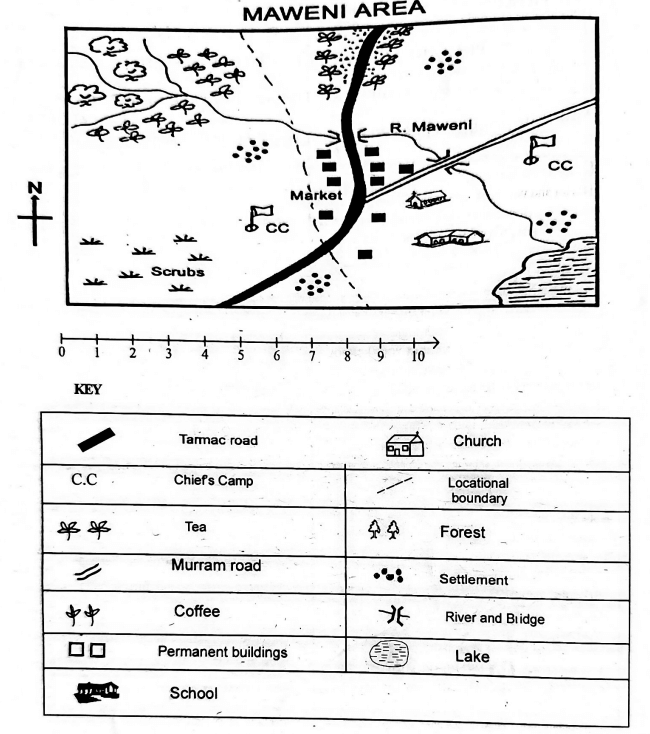
- The land in Maweni area slopes from
- North to West
- West to South
- North West to South East
- South East to North.
- Which type of climate is experienced in the Northern part of Maweni area?
- Hot and dry.
- Wet and cool.
- Cool and wet.
- Hot and wet.
- The main means of transport in Maweni area is
- road
- air
- water
- pack animals.
- The following shows that Maweni area is developed except the presence of
- farms
- factories
- roads!
- markets
- Maweni area is likely to be headed by a
- Chief
- Governor
- County commissioner
- Member of County Assembly.
- Which of the following is an indigenous beef cattle?
- Zebu
- Fresian
- Jersey
- Ayrshire.
- Which of the following is a characteristic of large-scale farming?
- Use of simple tools.
- Crops are grown for home use.
- Large tracks of land are cultivated.
- Use of family labour.
- Grade 6 learners wanted to practice fishing. Which main inland fishing ground in Kenya can they visit?
- Lake Turkana
- Lake Victoria
- River Tana
- Which language group in Eastern Africa has the least number of people?
- Bantu
- Cushites
- Semites
- Nilotes
- A tourist visited our country and saw writings on a banner at the airport about a citizen. Who is a citizen? A
- family member
- person who owns property
- person who runs from his/her country
- person who belongs to a particular country.
- During a group discussion, Grade 6 pupils listed the following examples of plains. Which answer did they give wrong?
- Lotikipi
- Nyambene
- Bilesha
- Kano.
- Which of the following is not an element of weather?
- Temperature
- Sunshine
- Cloud cover
- Rain
- Kibwana school has different leaders. Grade 6 learners asked their teacher to help them identify sections of leadership in the school. Which section of leadership is top in the structure in a school?
- Head teacher
- Deputy head teacher
- Board of management
- Parents.
- The figure below shows a land forming process.
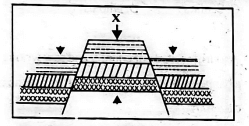
The force marked X is- compression force
- upthrust force
- tension force
- inertia.
- Which one of the following is not a block mountain?
- Aberdares Mountain
- Mt. Pare
- Mt. Ruwenzori
- Mt. Kenya
PART B: MUSIC
- Which of the following songs is wrongly matched with the purpose it serves?
- Patriotic - Praise leaders of a country.
- Popular - Pass a certain message.
- Lullaby - Comfort babies.
- D. Sacred - Please God.
- Which of the following values cannot be learnt from the East African Community Anthem?
- Selflessness
- Patriotism
- Tribalism
- Peace.
- Grade six learners sang the song 'Tushangilie Kenya' during a Nationa day celebration. The boys sang in bass and tenor while the girls sang in soprano and alto. We can say that this song was sung in
- unison
- harmony
- voice parts
- genders.
- Anita came across the wind instrument below. Identify its name and the community where it is used in folk song performance.
- Obokano-Kisii
- Adeudeu-Teso
- Orutu - Luo
- Sukuti-Luhya.
- When playing a chivoti, we can change the pitch of the tune by
- covering and uncovering the holes.
- pressing softly all the holes.
- pressing hard all the holes.
- only covering the holes.
- Kilumi dancers carried drums to perform in Music Festivals. The performers wore sisal skirts and decorated themselves with necklaces. The presentation was good but its ending did not please the judges. Which feature of a folk song did they fail to apply at the end?
- Instrumentation
- Costumes
- Climax
- Participants.
- Which solfa syllable is shown below?
- do
- mi
- re
- ti
- Sofi wanted to make a drum. Which of the following materials was she likely to use?
- Hollow wood, animal skin, string.
- Hollow wood, piece of cloth, strings.
- Hollow wood, animal skin, metal rod.
- Hollow wood, piece of cloth, animal skin.
- Grade 6 pupils were asked to identify the French rhythm name given to a semibreve. What was their correct response?
- Ta-te
- Taa-aa
- Taa-aa-aa-aa
- ta-te-taa
- During Music Festivals, a certain group of performers presented a folk song and the audience understood its message clearly. This
was probably due to- many facial expressions
- correct diction
- varied gestures
- high tempo.
PART C: ART AND CRAFT
Angela saw the item below on the Internet. Use it to answer questions 26 and 27.
- Which of the following tools was not used to create the displayed artwork?
- Scissors
- Steel nails
- Battens
- Mallet.
- The following techniques can be used to decorate the above artwork except
- incising
- stamping
- painting
- texturing.
- Shakilla wanted to draw a still life drawing. Which one of the following cannot be used to draw a still life?
- Imagination
- Tracing
- Observation
- Memory.
- Linet was preparing to mount her artwork for an exhibition. Which of the following factors was she not likely to consider?
- Proper labelling of the artwork.
- Adequate lighting of the exhibition room.
- Good arrangement of the artwork.
- Suitable background music
- Grade 6 pupils collected the following materials for making a door mat. Which of the following is an artificial material?
- Raffia
- Acrylic yam.
- Reed
- Sisal fibre.
- John was making improvised crayons using bee wax. Which of the following explains why he used two containers when melting the wax?
- To prevent fire accidents since wax is flammable.
- To enable the colour to mix well with the wax.
- To melt slowly.
- To ensure consistency in melting.
- Grade 4 pupils were provided with dye, strings, small stones and a white fabric for a dye and tie lesson. Which of the following techniques of tie and dye were they performing?
- Knotting
- Pleating
- Folding
- Stamping
- A grade 4 pupil was preparing to paint an imaginative composition. However, he noticed that his brush was missing. Which of the following materials would he not use to improvise a paint brush?
- Sisal fibre
- Feathers
- A sponge
- Grass.
- Celestine, a photographer was hired to take photos during a wedding ceremony. Which of the following aspects of photography was she not likely to observe
- Centering of the subject
- Proportionality
- Background
- ighting.
- Faith drew the figure below.
The figure displayed above is called- graduation
- staggered variation strip
- value strip
- blended gradation strip.
PART C: RELIGIOUS EDUCATION PART 1: Choose a section you have prepared for. Each section has 15 marks
CHRISTIAN RELIGIOUS EDUCATION
- Who among the following people worked for 14 years in order to get the girl he loved?
- John
- Job
- David
- Jacob.
- Jesus promised to send His disciples a helper whom he sent on the day of Pentecost. On that day, many people were filled with
- tongues
- fire
- holy spirit
- life.
- In the parable of the good Samaritan, the man who fell into the hands of robbers was going to
- Jericho
- Bethany
- Jerusalem
- Samaria.
- Which one of the following is not part of God's creation?
- Water
- Soil
- Car
- Man
- During the baptism of Jesus, the Holy Spirit came down in form of a
- pigeon
- dove
- duck
- raven.
- During break time, you find your best friend opening your bag without your permission. What is the best action to take?
- Report to the teacher.
- Forgive him and tell him to ask for anything he wants.
- Discuss the act with your friends.
- Stop your friendship.
- The following are reasons why Christians read the Bible. Which one is not? To
- strengthen relation hip with God
- get guidance on various issues
- strengthen faith in God
- pass exams.
- Sharing work and resources promotes all the following except
- love
- unity
- peace
- hatred.
- Which of the following parables reminds christians never to give up in life? The parable of
- the friend at midnight
- Pharisee and the tax collector
- the three servants
- the lost coin.
- On the way from School, Ali saw two boys fighting. What should he do?
- Stop them.
- Report them
- Reconcile them
- Run away.
- When the first humans disobeyed God, they
- were rewarded
- were chased from the Garden of Eden
- reconciled with God
- died.
- When Moses was taking care of the flock, he saw a burning bush. When he went near it,
- he was burned
- a voice told him to take off his shoes
- his stick changed to a snake
- one of the sheep disappeared.
- The Bible is divided into the Old and the New Testament. How many books does the Old Testament have?
- 66
- 27
- 39
- 47
- When Jonah was sent to Nineveh by God, he disobeyed. What did he do?
- He was swallowed by a big fish.
- He escaped to another place.
- God left him alone.
- He stayed at home and did nothing.
- Which of the following books of the Bible is a prophetic book?
- Isaiah
- Mathew
- Genesis
- 1st kings.
PART 2: ISLAMIC RELIGIOUS EDUCATION 3
- Which one of the following surahs of the holy Qur'an clearly explains the events of the day of judgement?
- Maun
- Nasr
- Zilzala
- Dhuha
- Grade 5 learners were discussing about the first revelation. Which one of the following surahs did they identify as the first to be revealed?
- Fatiha
- Nas
- Falaq
- Alaq
- When the prophet lost one of his sons, the Quraish mocked him saying that he had been cut off. Which surah did Allah reveal to console him?
- Asr
- Kawthar
- Nasr
- Tiyn.
- How old was the prophet when he lost his mother?
- 6 years
- 8 years
- 10 years
- 40 years
- Which one of the following brings love among the Muslims according to the hadith of the prophet (S.A. W)?
- Fasting
- Swalah
- Hajj.
- Greetings
- Muslims are allowed to take Tayammam when
- water is not available
- water is very cold
- one has to buy water
- there is a lot of sand and dust around.
- Which one of the following statements is true about the angels of Allah? They
- received books
- preached Islam
- advice Allah
- obeyed the command of Allah,
- Angels are created from
- nar
- clay
- nur
- water...
- When Hussein was on his way back home, he saw some Muslims who were standing throughout their prayer. Which prayer were they performing?
- Eid
- Jum'aa
- Janaza
- Dhuhr.
- The first muadhin was called by
- Umar
- Bilal
- Abubakar
- Ali.
- A prophet of Allah was thrown in fire to burn off but Allah (S.W) ordered fire, "Be cool and safe on my servant'. This was Prophet
- Nuh (A.S)
- Yusuf (A.S)
- Musa (A.S)
- Ibrahim (A.S).
- How many brothers did Prophet Yusuf (A.S) have?
- 11
- 10
- 12
- 13
- What are Hadith?
- Stories of Prophets.
- Sayings of Swahabas.
- The history of Islam.
- Sayings of the Prophet.
- In the hadith of the prophet, we learn that Allah (S.W) judges people basing on their
- actions
- appearance
- wealth
- race.
- What did Allah promise those men who wear women clothes and women who wear the male clothing according to Hadith?
- Reward
- Punishment
- Curse
- Confusion.
MARKING SCHEME
SOCIAL STUDIES
- C
- C
- A
- B
- C
- A
- C
- B
- C
- D
- B
- D
- C
- B
- D
- B
- C
- B
- C
- A
- C
- B
- A
- C
- B
- C
- D
- B
- D
- B
- A
- B
- D
- D
- B
C.R.E
- D
- C
- A
- C
- B
- B
- D
- D
- A
- C
- B
- B
- C
- B
- A
I.R.E
- C
- D
- B
- A
- C
- A
- D
- C
- C
- B
- D
- A
- D
- A
- B
Creative Arts, Social Studies & Religion Questions and Answers - Grade 6 Mid Term 2 Exam 2023 Set 2
SECTION 1:ART AND CRAFT.
Study the following picture and answer questions 1 and 2.
- The picture making technique used in shading the picture above is called _________________________.
- smudging
- cross hatching
- crayon etching
- stippling
- How has the dark effect been created in the picture?
- By shading with widely spaced criss crossing lines
- By smudging the dry media uniformly
- By ensuring that the objects overlap
- By applying dots close together
- Maxwell is an upcoming artist. Which one of the following factors would you not advise him to consider when drawing forms?
- Size
- Balance
- Proportion
- Space
- Painting is ________________________.
- Diluting colours using water
- Adding black or white to a colour
- Using brush and paint to decorate an image
- Pasting related pictures on a surface to make an artwork
- What is an imaginative composition?
- Creating artworks of things never seen before
- Copying an already existing artwork
- Drawing from observation
- Drawing of human forms
- Which one of the following is not a demonstration of craftsmanship when making a montage composition?
- neat application of adhesive
- neat overlapping of cut out forms
- inconsistency in cutting of the artworks
- fitting the artworks in the drawn picture frame
- Which one of the following statements is incorrect?
- A woven artwork has warps and wefts
- Basketry artworks have rolled or plaited coils bound by stitching
- Both mats and baskets are products of weaving
- The coil and stitch technique is a basketry technique
- The following are natural sources of materials that can be used in the coil and stitch technique. Which one is the odd one out?
- Rafia
- Sisal fibre
- Banana leaves
- Polyester yarn
- Which one of the following is not a safety tip when preparing materials for coil and stitch technique in basketry?
- Wear protective clothes
- Only rest when all the materials are prepared
- Take care when using sharp cutting tools
- Always work in a spacious room or area
- A good floor mat made by plaited or rolled coils has the following characteristics except.
- durable
- cleanable
- non-slippery
- easy to tear
- What is the use of the following tool when making a beaded leather wrist band?
- Punching holes into the leather wristband
- Attaching beads on the leather wristband
- Tracing line patterns on the leather wristband
- Stitching different pieces of leather together
- Christine made a beaded wristband. What would she use it for?
- Wearing on her hand to enhance her appearance
- Fastening her blouse with it instead of using buttons
- Hang it on the wall in the house as a decoration
- Carrying pens and pencils to school
- The clay that has been dried, fired, crushed and added to normal clay is called ____________________
- grog
- bisque ware
- leather hard cla
- slip
- Which of the following are ways of decorating modeled clay items?
- Embedding and piercing
- Embossing and smoking
- Burning and texturing
- Polishing and piercing
- What is carving?
- Making a product using leather
- shaping an item from a hard material such as wood, stone or metal
- Decorating a clay item before it dries completely
- Making items using fibre by weaving and plaiting
SECTION 2:MUSIC
For questions 16-19, complete the table below by choosing the correct options out of the given four.
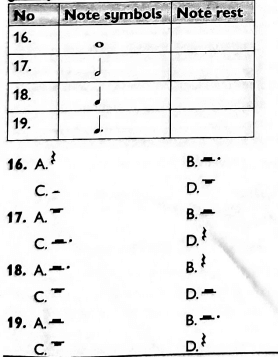
- What is the note symbol for ?
- In a four-beat pattern, the occurrence of strong beats happens after?
- Three beats
- Four beats
- Two beats
- Every beat
- Which one shows the highest pitch discrimination between the sol-fa syllables?
- f to d1
- s to r
- m to f
- r to d1
- Which method was used to create the melody below?
- Improvisation
- Alteration
- Slight variation
- Repetition
- Matthew created the following melody.
d, r, m, s, d, r, m, s
Which method did he use to come up with the melody?- Alteration
- Repetition
- Mirror
- Slight alteration
- How many sounds are in the range d−d1?
- 1
- 8
- 7
- 6
SECTION 3: SOCIAL STUDIES.
- The following are countries found in the Eastern African region. Which of them is not correct?
- Somalia
- Eritrea
- Zambia
- Uganda
- Kenya lies to the __________________________Somalia.
- East
- Westy
- South
- North
- Which lake is marked x on the diagram?
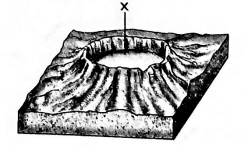
- Crater lake
- Lava damned lake
- Rift valley lake
- Tarn lake
- Kilemia has a tea plantation in his county. Which climatic region influences growth of his tea?
- Desert
- Mountain
- Tropical
- Equatorial
- What type of vegetation is shown below?
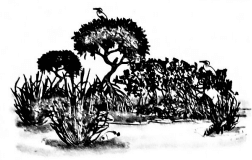
- Mangrove
- Savannah
- Tropical rainforest
- Mountain
- What is the main importance of Fort Jesus in Kenya?
- Attracts tourists.
- Preserve Swahili culture
- It is a source of knowledge.
- Protects the environment.
- The last Bantu community to migrate into Eastern Africa, were the ________________________. They were escaping from the raids by the Zulu of South Africa.
- Abaluyha
- Luo
- Somali
- Ngoni
- Most of the people are allowed by the government to settle around the game parks and airports.
- True
- False
- The following are the aspects of African traditional culture. Which one among them ought not to be preserved?
- Use of elders to settle disputes.
- Traditional foods.
- Eradication of traditional songs and dances.
- Respect for the elders.
- What benefit does your school benefit from your community?
- Community gives free land to school.
- School gives scholarship.
- School creates employment.
- School builds community.
- Non-teaching staff and school ground is acquired from the _____________________________.
- Community
- Head teacher
- School
- Church
- Study the activity below and say what the learners and community members are doing together.
- Market cleaning day.
- School general cleaning.
- Learners trading.
- Traders selling items.
- Maguna harvests his crop as shown below. Which characteristic of large scale farming does the picture show?
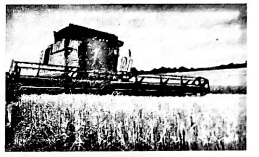
- Use of heavy machines
- Human labour
- Large capital
- Produce for sale
- Which of the following crops is not grown on large scale?
- Tea
- Coffee
- Cassava
- Pyrethrum
- What is the main contribution of large scale farming to the country?
- Job creation
- Raw materials
- Large capital
- Foreign exchange
SECTION 4:
CHRISTIAN RELIGIOUS EDUCATION.
- The following are benefits of using our talents and abilities well. Which one is not
- We can earn income if we use our talents and abilities well
- We can serve others using our talents and abilities
- We become aware of God's purpose for our lives when we use our talents and abilities well
- We lose our focus in life when we concentrate on our talents and abilities
- A Christian may spend their leisure time doing all these activities except?
- Worshipping God
- Reading the Bible
- Helping the needy
- Taking drugs
- Which among the Ten Commandments has a promise to it?
- Second
- Fourth
- Fifth
- Third
- Which Bible story teaches us about determination?
- The story of Elisha and how he recovered an axe head
- The story of Jacob wrestling with God
- The story of baby Moses being rescued by Pharaoh's daughter
- The story on the call of Moses
- How many prophets of Baal were at the contest on mount Caramel?
- 300
- 450
- 200
- 100
- Which of the following shows qualities of a false god?
- He answers prayers
- He is a provider
- He is powerful
- He does not listen to the prayers for those who pray to them
- God's power helped Samson to defeat
- The Philistines
- The Galatians
- The Israelites
- The Egyptians
- Marriage is meant for ____________________________
- People under the age of 18 years
- People who are above the age of 18 years and are ready for commitment
- Children who are still in school
- All girls who have not gone to school
- What lesson is not taught by the story of the call of the first disciples?
- We should not obey when God calls
- We should have faith in God
- God calls people to serve Him
- You can serve God in your workplace 5
- Select the symbol which is matched to its meaning according to the parable of the hidden treasure.
- The man - The word of God
- The field - Normal way of living
- The property that was sold - Christian
- The hidden treasure - The Kingdom of God
SECTION 4:
ISLAMIC RELIGIOUS EDUCATION.
- According to Sural Al-Zilzalah _______________ shall signify the day of judgement.
- floods
- rain
- fire
- earthquake
- Complete the verse: Wakalal insanu ______________________
- Zilzalaha
- Ma'alaha
- Bianna rabaka
- Athkalaha
- Which word means to completely trust Allah?
- Tawaakul
- Taqwa
- Sunnah
- Tawakkul
- The first Wahy (revelation) from Allah was on ______________________.
- Swalah
- religion
- knowledge
- faith
- Which one among the following does not nullify Swalah?
- Eating and drinking
- Turning away from Qibla
- Overtaking the Imam
- Using tayammum for wudhu
- Taqwa can be demonstrated through three of the following except one. Which one?
- Being truthful
- Forgiving
- Independent
- Applying justice
- Which statement is false?
- A guest is a gift.
- A guest comes with sustenance.
- A guest carrys away sins of family
- A guest is a burden.
- Repentance is referred to as ______________________________
- Ihsan
- Taubah
- Amal
- Dua
- Complete the hadith: Search for knowledge is a duty to _____________________ male and female.
- some
- old
- every
- young
- Who among the following are not Muttaqiins?
- Prophets
- Shahid
- Auliya
- Zuhd
MARKING SCHEME
ART
- D
- D
- A
- C
- A
- C
- C
- D
- B
- D
- A
- A
- A
- A
- B
MUSIC
- D
- B
- B
- B
- A
- B
- D
- D
- B
- B
SOCIAL
- C
- B
- A
- C
- A
- A
- D
- B
- C
- A
- A
- A
- A
- C
- D
C.R.E
- D
- D
- C
- B
- B
- D
- A
- B
- A
- D
I.R.E
- D
- B
- D
- C
- D
- C
- D
- B
- C
- B
Creative Arts & Social Studies Questions and Answers - Grade 6 Opener Exams Term 2 2023 Set 3
ART AND CRAFT
- The technique of shading where dots are used to show value on drawn forms by arranging them close together to show darker and lighter parts is known as
- smudging
- tonal value
- stippling
- painting
- What is the result of mixing the following colours
Primary Colour + Secondary colour:- secondary colour
- tertiary colour
- primary colour
- orange
- The drawing involves forms that one has not seen or interacted with before is known as
- drawing from observation.
- imaginative composition
- still life drawing
- cross hatching
- An imaginary line that divides a drawing into two halves is called
- axis
- depth
- equator
- balance
- The technique that involves applying of paint on a pictorial composition is known as
- crayon etching
- painting
- smudging
- shading
- Which one of the following is not a principle of art?
- Shapes
- Balance
- Proportion
- Rhythm and movement
- Which one of the following materials cannot be used to create montage in pictorial composition?
- Brushes
- Manilla paper
- Glue
- Wet soil
- What does overlapping of cut-out images in montage create?
- Balance
- Manilla paper
- Glue
- Wet
- A basketry technique that involves coiling planted or rolled coils into a spiral and stitching them at each row to hold and secure in place is referred to as
- coiling
- stictching
- coil and stitch
- basketry
- When decorating a wristband, which one of them following materials cannot be used?
- Beads
- Strings
- Scissors
- Axe
MUSIC
- A performance where three people sing a 3-part song is called
- duet
- trio
- solo
- choral
- Songs performed by people from the same community are called
- sacred songs
- patriotic songs
- topical songs
- folk songs
- Which one of the following is not a feature ofa folk song?
- Mood
- Structure
- Climax
- Choral
- The gradual increase in volume when singing using a musical instrument is
- trio
- duet
- crescendo
- diminuendo
Use the musical instrument below to answer question 15 and 16.
- The musical instrument below is called?
- Adeudau
- Wandindi
- Abu
- Drum
- The musical instrument can be played by
- blowing
- plucking
- beating
- hitting
- The songs that are sung to show things that affect the community are called
- topical songs
- patriotic songs
- popular songs
- sacred songs
- Which one of the following voice parts can be sung by girls only?
- Soprano
- Bass
- Tenor
- Solo
- The musical note drawn below is called
- crotchet
- semibreve
- minim
- quaver
- The clothes worn by dancers during performance of songs are called
- uniforms
- props
- ornaments
- costumes
SOCIAL STUDIES
- Below are characteristics of a vegetation Zones in Eastern Africa
- Trees are tall
- Trees grow close together
- Trees are evergreen
- Trees have broad leaves
The vegetation zone described above is- rainforest vegetation
- mangrove vegetation
- swamp vegetation
- savannah vegetation
- Arabs came to settle in Eastern Africa MAINLY insearch of
- goods for trade
- fertile soils
- pasture and water
- iron for tool making
- Below are examples of physical features. Choose the one that is a drainage feature.
- Escarpment
- Valley
- River
- Hill
- The MAIN factor influencing population distribution in Eastern Africa is
- distribution of towns
- amount of rainfall
- availability of jobs
- availability of minerals
- Grade 6 learners can take part in community.development by
- making school rules
- building roads
- opening up business
- cleaning the local market
- The following are relief features in Eastern Africa. Which relief feature discourage human settlement?
- Plains
- Steep slopes
- Plateaus
- River valleys
- Grade 6 learners went on a field trip. They passed through a town where they saw many poorly built houses close together. The problem LIKELY to be found in such places is
- road accidents
- diseases
- low rainfall
- overcrowding
- The diagram below represents the formation of relief rainfall
The area marked X receives less rainfall because- it lies at a low altitude
- it has little vegetation cover
- it is sheltered from warm moist winds
- it is far from large water bodies
- Mekatilili wa Menza led the Agiriama people in fighting the British because
- the British stopped them from trading
- the British interfered with the independence
- the British were building a railway line
- the British sold them into slavery
- In Kenya diatomite is mined at
- Kimwarer in Kerio valley
- Bamburi in Mombasa
- Athi River in Machakos
- Kariadusi near Gilgil
- Kivoi wa Mwendwa was a great trader of the
- Akamba people
- Agikuyu people
- Agiriama people
- Ameru people
- A county government in Kenya is headed by
- a county commissioner
- a county representative
- a governor
- a senator
Use the map of Eastern Africa below to answer questions 33 to 35.
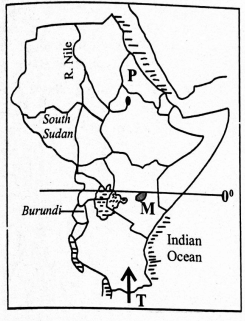
- The community that used the route marked T during the migration period is
- Chagga
- Ngoni
- nyamwezi
- Hehe
- The administrative capital city of the country marked P is
- Mitsiwa
- Djibouti
- Asmara
- Addis Ababa
- The shaded area marked M is densely populated due to
- presence of large towns
- mining activities
- availability of jobs
- availability of high rainfall
PART 11
CHRISTIAN RELIGIOUS EDUCATION
- The commandment that teaches Christian to respect the property of other people is
- "Do not accuse anyone falsely"
- "Do not commit murder"
- "Worship no other god but me"
- "Do not steal"
- God rested on the seventh day during the creation period because
- he was tired
- he had completed creation
- it was a day of rest
- he wanted to create human beings
- When Jesus called Peter and Andrew they were
- fishing
- collecting taxes
- looking after sheep
- offering a sacrifice
- Which one of the following was a tempetation of Jesus. The devil told him to
- change water into wine
- walk on water
- change a stone into bread
- raise a dead person
- The story of Jacob Wresting with an angel of God at Peniel teaches Christians to be
- brave
- determined
- courageous
- humble
- Jesus healed the Roman officer's servant inthe town of
- Capernaum
- Jerusalem
- Bethany
- Nain
- Which one of the following values is the MOST important in a Christian marriage?
- Wealth
- Education
- Faithfulness
- Smartness
- A Christian value learnt from the story of prophet Elisha raising an axe-head is
- courage
- humility
- patience
- faith
- God sent Adam and Eve out of the Garden of Eden because
- they disobeyed his commands
- they spoke to the snake
- they made clothes from leaves
- they hid in the garden
- The MAIN teaching of Jesus during the sermon on the mountain is
- helping people in need
- repenting sins
- living lives that please God
- accepting others
- At the time of the birth of Jesus his parents had gone to Bethlehem to
- Visit their relatives
- register there
- attend the passover feast
- escape from Herod
- The MAIN message of John the Baptist when he preached was
- tolerance
- patience
- repentance
- honesty
- Jesus compared the growth of the kingdom of God to
- a mustard seed
- a lost coin
- a fig tree
- a narrow door
- God called Moses in Midian to go to Egypt to
- perform miracles in Egypt
- lead the Israelities out of Egypt
- offer sacrifices in Egypt
- receive the ten commandments
- The donkey of Balaam spoke because
- an angel was blocking the way
- Balaam beat it
- God made it to speak
- it was tired of carrying Balaam
PART 11
ISLAMIC RELIGIOUS EDUCATION
- The story of Elephant is taught in which Surah?
- Kauthar
- Humazah
- Fiyl
- Kaafirun
- The Surah which tells us about the events of the last day is?
- Qariah
- Humazah
- Takathur
- Maun
- The Surah that emphasises on the important
- Maun
- Nas
- Fatiha
- Asr
- According to the hadith of purity of actions Allah does not check at our?
- Hearts
- Appearance
- Actions
- Life
- Which one of the following is a male dress code?
- It should cover the whole body except the palms and face
- It should be made from Gold
- It should cover between the navel and the knees
- It should not be made of women
- Which is the fourth article of faith in Islam?
- Belief in Allah
- Belief in Books
- Belief in Qadar
- Belief in prophets
- The name of Allah (SWT) Al-Malik means?
- The master
- The all knowing
- The forgivers
- The creator
- Who took care of prophet Muhamamd after he preached wasthe death of his mother?
- Abu Talib
- Abdul Mutwalib
- Abu Jahal
- Abu Dharri
- the last Sunnah prayer performed at night is
- Witr
- Taraweh
- Qabliyah
- Baadiyah
- Complete the following hadith of the prophet (P.b.u.h): "I have been sent for the purpose of prefecting"?
- good morals
- human beings
- life
- faith
- When Said goes to school in the morning and meets her classmates, the first thing for her to do according to of prophet (S.A.W) is to?
- Wait for them to greet her
- Keep quiet
- Greet her
- Smile at her
- Muhammad was found making noise in class, the teacher asked to name his friends who were also making noise and he named all of them. Which quality of the prophet did he display
- patience
- kindness
- honesty
- generosity
- Which one of the following is an obligation of patience is of parents to their children
- Buying them gifts
- Paying school fees for them
- Buying them a mobile phone
- Buying them toys
- Which prophet was thrown in the fire by his people?
- Harun
- Muhammad
- Nuh
- Ibrahim
- Iddul Fitr is celebrated on?
- First Ramadhan
- First Shawwal
- Thirtieth Ramadhan
- Second Shawwal
MARKING SCHEME
ART/CRAFT
- C
- B
- B
- A
- B
- A
- D
- C
- C
- D
MUSIC
- B
- D
- D
- D
- A
- B
- A
- A
- C
- D
SOCIAL
- A
- A
- C
- B
- D
- B
- D
- C
- B
- D
- A
- C
- B
- C
- D
C.R.E
- D
- B
- A
- C
- B
- A
- C
- D
- A
- C
- B
- C
- A
- B
- C
I.R.E
- C
- A
- D
- B
- C
- D
- A
- B
- A
- A
- C
- B
- B
- D
- B
Creative Arts & Social Studies/R. E Questions and Answers - Grade 6 Opener Exams Term 2 2023 Set 2
ART AND CRAFT
- The technique that involves using dots to create value and make an object look like solid while on a drawing surface is known as
- cross hatching
- smudging
- stippling
- collage
- What is the main function of soap in crayon etching?
- To make the crayons mix well.
- To make the Indian ink to stick well on the waxed surface.
- To add texture and beauty to the crayon composition.
- To make the surface smooth for scratching.
- Alice modelled the item below.
She can use the following methods to decorate it except- incising
- embossing
- stamping
- kneading
- Junet described what calligraphy is. Which one is the correct answer?
- The art of writing on a surface using a pen.
- The art of writing using a brush and paint.
- The art of writing with a beautiful handwriting using a special pen.
- An art of writing words and drawing pictures.
- Grade six learners explained what tertiary colours are. Choose the correct answer they gave?
- Any colour obtained from nature.
- Colours obtained by mixing primary and secondary colours in equal proportion.
- Colours obtained by mixing two or more colours.
- Colours obtained by mixing primary colours.
- Which of these statements best describes montage?
- The art of cutting pictures.
- The art of cutting and pasting pictures on a surface.
- The art of drawing pictures on a surface.
- The art of creating pictures on a surface.
- Which option shows the best source of montage pictures?
- Textbooks
- Storybooks
- Dictionary
- Old newspapers and magazines
- The following are factors to consider when painting. Which one is not?
- Subject matter
- Proportionality
- The type of paint palette.
- Centre of interest.
- Onyango drew the picture below. What is the name of the art shown?
- Stick puppet
- Glove puppet
- Marionette
- Rod puppet
- Which pair consists of natural materials that are used in basketry?
- Polyester, yarn
- Wool, nylon
- Carbon fibre, reeds
- Raffia, sisal fibre
MUSIC
- Which of the following lines is found in the East African Community anthem?
- Ee Mungu tunakuomba.
- Ee Mungu wewe ni mkuu.
- Ee Mungu twaomba uilinde.
- Wewe ni Mungu wetu.
- The highness or lowness of voice while singing is called _______________________________
- rhythm
- pitch
- melody
- volume
- "Muturiru" is wind instrument that is used by which community in Kenya?
- Luhya
- Kikuyu
- Mijikenda
- Kalenjin
- What is the French rhythm of the note below?
- Taa-aa
- Ta-te
- Taa
- Taa-aa-aa
- A certain community group is singing dirges. The songs being sang are most likely
- funeral songs
- wedding songs
- initiation songs
- praise songs
- The following are performance etiquettes when presenting folk songs. Which one is not?
- Dress appropriately.
- Maintain enough space between participants.
- Never acknowledge the applause from the audience.
- Do not stare at the audience whenever one of the presenters makes a mistake.
- The following are aspects of a folk song except one. Which one it is?
- Occasions
- Instrumentation
- Participants
- Body adornment.
- A grade seven learner was singing the song below.
Wash you hands,
Osha mikono,
Sisi sote,
Wash your hands.
The above song is an example of ______________________________________- action song
- sacred song
- topical song
- lullaby song
- The following are roles of a soloist. Which one is not?
- Starting a dance.
- Pitching singers so that they sing without straining.
- Addressing the audience while commanding singers.
- Creating disharmony.
- Which of the following musical instruments is played by bowing?
- Orutu
- Chivoti
- Biringi
- Nzumari
SOCIAL STUDIES
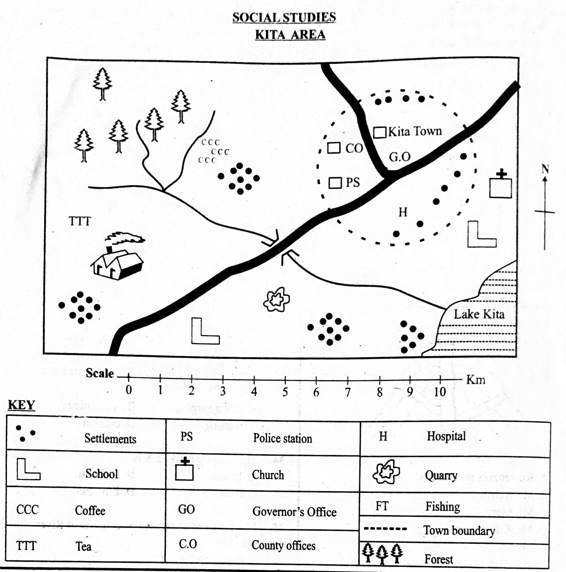
Study the map of Kita area and answer questions 21-25
- Peter walked from the forest to lake Kita. Which direction was he walking from?
- North West
- South East
- South West
- North East
- The climate in the North Western part of Kita area is
- hot and wet
- cool and wet
- hot and dry
- cool and dry
- The following economic activities are practised in Kita area except
- lumbering
- mining
- farming
- fishing
- The elected head of Kita area is a
- County Commissioner
- Chief
- Governor
- Senator
- The type of settlement in Kita area is mainly
- clustered
- linear
- sparse
- scattered
- Grade six learners were asked to identify the countries of Eastern Africa. Who among the following was wrong?
- Sophia - Somalia
- Lydiah- Democratic Republic of Congo
- Obed - Eritrea
- Richard - South Sudan
- Identify the position of Eastern Africa in terms of longitudes and latitudes
- 17° W, 51° E and 37° N and 35° S
- 23°E, 51°E and 22°N, 12°S
- 37°W, 35°E, 17°W, 51'S
- 22°E, 12°E and 23°N, 51°S
- Grade six learners were asked by their Social Studies teacher to name the physical feature drawn below. Who gave a wrong answer?
- Ruwenzori mountains
- Mt. Kenya
- Mt. Meru
- Mt. Kilimanjaro
- The diagram above was formed through a process known as
- faulting
- volcanicity
- folding
- erosion
- The Great Rift valley passes through the following countries except
- Kenya
- Ethiopia
- Sudan
- Uganda
- A group of people who descended from a common ancestor is called
- family
- clan
- tribe
- community
Use the map of Eastern Africa below to answer questions 32-34.
- The town marked Z is
- Addis Ababa
- Juba
- Khartourm
- Mogadishu
- The shaded lake marked Y was formed as a result of
- downwarping
- volcanicity
- faulting
- erosion
- The country marked X is
- Eritrea
- Djibouti
- Somalia
- Ethiopia
- Which pair of communities consists of River Lake Nilotes?
- Shilluk, Nuer
- Acholi, Jie
- Luo, Ogiek
- Njemps, Dorobo
SECTION A:
CHRISTIAN RELIGIOUS EDUCATION
- Grade six learners in Kumi primary school were asked by their CRE teacher to state what was created by God on the 5th day. Who among them gave the correct answer?
- James-sun, moon and stars
- Jane-sea creatures and birds
- John-earth, sea and plants
- Josphine - the skY
- Which one of the following parables of Jesus teaches Christians to use our God given talents well? The parable of the
- mustard seed
- sower
- three servants
- ten virgins
- According to Exodus 31:3, whom did God choose to build the covenant box?
- Hur
- Uri
- Bezalel
- Judah
- A group of people related by blood, marriage or adoption is called
- clan
- family
- tribe
- age group
- Which one of the following is not a type of marriage recognized in Kenya?
- Come we stay marriage
- Christian marriage
- Customary marriage
- Civil marriage
- The time we have when we are free from normal routine work is called
- celebration time
- leisure time
- personal time
- idle time
- The books of the law in the Bible include three of the following except
- Genesis
- Exodus
- Leviticus
- Proverbs
- Which of the ten commandments teaches Christians to respect their marriages?
- The 5th
- The 6th
- The 7th
- The 8th
- According to Jesus, the greatest commandment is the commandment of
- wisdom
- love
- respect to human life
- respect to people's property
- Samson defeated the Philistines because
- of God's power in him
- of the unshaved hair
- of his own strength
- of his own secrets
- Grade six learners were asked by their C.R.E teacher to identify the miracles of prophet Elisha. Who did not give the right response?
- Feeding 1000 prophets
- Healing Naaman of his leprosy
- Raising the son of the widow of Zarephath
- Floating and recovering the lost axe head
- Which response did Jesus give when the devil asked him to throw himself down from the top of the temple?
- Man shall not live on bread alone
- Worship the lord your God and serve only him
- Do not put the Lord your God to test
- I am the light of the world
- Jesus healed the Roman officer's servant because
- of the servant's faith
- of the officer's faith
- Jesus had mercy on him
- he was righteous
- During which miracle did Jesus weep?
- Crucification
- Raising of Lazarus
- Changing water into wine
- Baptism
- On your way to school, you find two of your school mates in grade three fighting over the ownership of a pen. As a Christian, what should you do?
- Run to school so as not to get late
- Help one of them who is your friend
- Report them to the head teacher
- Separate them and try to find out who the owner of the pen is.
SECTION A:
ISLAMIC RELIGIOUS EDUCATION
- Rahma a grade six learner found her friends backbiting their teacher. Which surah can she encourage them to read?
- Al-Fatiha
- Al-Humaza
- Al-Falaq
- Al-Quraish
- "Except those who believe and recommend one another to patience, "This quotation is from surah
- Asr
- Maun
- Masad
- Fiil
- The surah of the Qur'an that must be recited in every prayer is
- An-Naas
- Al-Falaq
- Al-Humaza
- Al-Fatiha
- Zakaria left his home to school in a long sleeved shirt and a pair of shorts. Which part of his body was naked?
- The head
- The stomach
- The navel
- The knees
- Muhammad is a farmer who has planted many trees. Three of the following are importance of planting trees except
- provide shade for people
- provide food for people and birds
- provide home for people
- provide home for birds
- Three of the following are bounties that Allah has given human beings. Which one is not?
- Health
- Women
- Legs
- Life
- Muna a grade six learner was discussing with his friend the pillars of Iman. How many pillars do you think they are likely to have discussed?
- Six
- Seven
- Eight
- Four
- Three of the following are qualities of a Mutaqeen. Which one is not?
- They fear Allah
- They avoid all sins
- They commit shirk
- They give out in charity
- Hasfa was preparing a wall chart for class on the Angels of Allah and their duties. Which angel did she record as the angel of Wahy?
- Mikail
- Ridhwan
- Jibril
- Izrail
- Which one of the following prayer is performed at 6.30 pm?
- Isha
- Dhuhr
- Asr
- Maghrib
- While discussing the attributes of Allah, Maslah a grade six learner wanted to know from her friends the meaning of Al-Khaaliq. What was the possible answer that Maslah may have received?
- The creator
- The sustainer
- The judge
- The fashioner
- On his way to school, Mullah a grade six learner collected broken pieces of bottles from the road and threw them away in the dustbins alongside the road. This act is referred to as
- sadaqah
- zakah
- goodness
- kindness
- Three of the following are characteristics of the angels of Allah. Which one is not?
- They are neither male nor female
- They eat and drink
- They are made from light
- They do not disobey Allah (S.W.T)
- Which one of the following is the first month of Islamic calender?
- safar
- Ramadhan
- Muharram
- Shaban
- Nasteha a grade six learner was studying on the family tree of the prophet (S.A.W). Whom do you think she is likely to have found out to be the mother of prophet Muhammad (S.A.W)?
- Halima
- Khadija
- Aisha
- Amina
MARKING SCHEME
ART & CRAFT
- C
- B
- D
- C
- B
- B
- D
- C
- B
- D
MUSIC
- C
- B
- B
- C
- A
- C
- D
- C
- D
- A
SOCIAL
- A
- B
- A
- C
- A
- B
- B
- A
- B
- C
- B
- D
- A
- A
- A
C.R.E
- B
- C
- C
- B
- A
- B
- D
- C
- B
- A
- C
- C
- B
- B
- D
I.R.E
- B
- A
- D
- D
- C
- B
- A
- C
- C
- D
- A
- A
- B
- C
- D
Creative Arts, Social Studies & Religious Education Questions and Answers - Grade 5 Mid Term 2 Exam 2023 Set 3
SECTION 1:ART AND CRAFT.
- Which one of the following is not an element of art?
- Line
- Shape
- Value
- Form
- The following are principles that should guide an artist when creating a still life compositing except __________________________.
- balance
- proportion
- overlapping
- texture
- The following diagram shows a ____________________________.
- collage
- painting
- still life drawing
- crayon etched picture
- What is cross hatching?
- Using parallel intersecting lines to shade a drawn object
- Using water colours to decorate a drawing
- Smearing a drawing made using dry media
- Using a sharp object to draw on a crayon waxed surface
- What is a tertiary colour?
- A colour created by mixing two primary colours
- A colour created by mixing two secondary colours
- A colour created by mixing a primary and secondary colour
- A colour created by mixing black or white to any colour
- Which of the following colour combinations wrong?
- Yellow + orange = yellow-orange
- Red + violet = red-orange
- Yellow+green green-yellow
- Blue + green = blue-green
- A lighter tone of a colour can be created by adding _______________________________.
- water to it
- black colour to it
- white colour to it
- both black and white colours to it
- What is collage?
- pasting textured materials on a surface to create a picture
- cutting and pasting related pictures to make an artwor
- making a picture by drawing with a pencil before painting
- drawing on a crayon waxed surface covered in black ink using a sharp object
- Textured materials from the environment that can be used to make a collage include all of the following except ___________________.
- leaves
- ree bark
- inedible seeds
- old newspapers
- Pictures A and B below show ________________________ and _______________________methods of weaving respectively. B
- coil and plain
- twine and plain
- plain and twine
- twine and coil
- Which one of the following not a method used to prepare weaving materials?
- Splitting
- Soaking
- Stripping
- Smoking
- Pots made using the pinch technique can be decorated in the following ways except by _________________________.
- stamping
- scratching
- incising
- beading
- In pottery, the mud-like clay used as glue for sticking slabs together is called ____________________________.
- grog
- mud
- slip
- adhesiv
- Grade 5 leaners in Al Hadasa School collected the following materials for an Art and Craft lesson:
- Carving tool
- Soft wood
- Sand paper
- Mallet
Which activity were they preparing for?- Weaving
- Carving
- Pottery
- Painting
- Which of the following are not techniques used to decorate a ladle?
- Smoking and texturing
- Burning and polishing
- Incising and embossing
- Beading and piercing
SECTION 2:MUSIC
For questions 16-19, choose the correct answer out of the four options given below to complete the table.
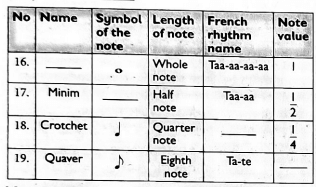
-
- quaver
- semibreve
- Crotchet
- Dotted minim
-
-
- taa
- ta-te
- taa-aa
- taa-aa-aa
-
- 1/8
- 2
- 1½
- 2/8
- Melody of a song is referred to
- pitch and rhythm
- dynamics and tempo
- pitch and dynamics
- tempo and pitch
- Complete the ladder below
- d, r
- r, d
- f, s
- f, r
- Which of the following is not a wind instrument?
- Guitar
- Horn
- Descant recorder
- Flute
- What type of instrument is a descant recorder?
- Percussion
- String
- Wind
- Idiophone
- What is a duet?
- A performance for four people
- A performance for two people
- A performance for five people
- A performance for one person
- When singing, doh is lower in ___________________ than re.
- Melody
- Pitch
- Volume
- Rhythm
SECTION 3: SOCIAL STUDIES.
Study the map below and answer the questions that follow.
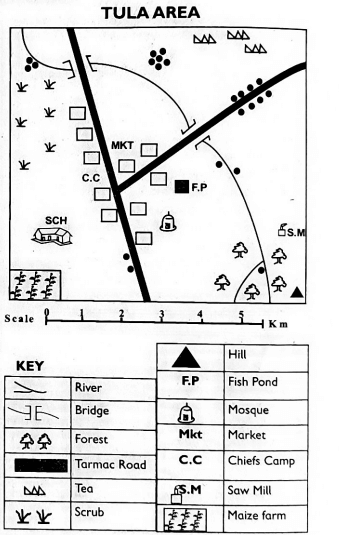
- What is the title of this map?
- County
- Key
- Tula Area
- Bondeni Area
- The following economic activities are carried out in area shown. Which one is not true?
- Farming
- Worshipping
- Trading
- Lumbering
- Who is the head of the area shown above?
- Chief
- Governor
- MCA
- District Commissioner
- Kerubo wanted to visit Tula Area to start a business activity in the market. What could give her direction to her place of destination?
- Compass
- Scale
- Title
- Frame
- Which lake is shared by two countries that border Kenya to the South and to the West?
- Lake Turkana
- Lake Victoria
- Lake Baringo
- Lake Nakuru
- Mt Elgon is found at the border of Kenya and ___________________________.
- Tanzania
- Somalia
- Ethiopia
- Uganda
- Which of the following weather elements is not correctly described?
A. Rainfall Rain supports the growth of vegetation. B. Wind Warm and moist winds bring rain. C. Cloud cover Heavy cloud cover brings heavy rainfall. D. Temperature Refers to ice on the mountain. - Muuo wrote the following characteristics to describe a climatic region in Kenya.
- The windward side receives relief rainfall while the leeward side is drier.
- Temperatures range from 0°C - 15°C.
- Experiences cool and wet conditions.
The climatic region described above is ____________________________.- Mountain climate
- Tropical climate
- Modified Equatorial climate
- Desert climate
- Who among the following learners did not give the correct importance of historic built environments?
A. Manasseh They remind and teach us about our culture. B. Sharon They bring rain to our land. C. Baraka They are sources of information for learning. D. Gakii They are sources of employment for people who work there. - The following are ways in which language groups depend on each other. Which of them is not correct?
- Treatment
- Trading
- Iron making
- Tribalism
- Learning from specialists was a method of instruction used in African traditional education. Boys and girls were taught the following skills except.
- Pottery
- Basketry
- Singing
- Beading
- Mukabane is the head teacher of Bidii Primary School. Which of them is not one of his duties to perform in school?
- Secretary of the staff meetings.
- Overall in charge of the school.
- Maintains school records.
- In charge of funds and security.
- Danilo listed the following importance of resources in our environment. Which of them is not correct?
A. LAND We grow crops and keep animals on it. B. MINERALS Valuable substances like soda ash beautify our environment. C. WATER Source of water for crops and animals and fish such as tilapia. D. FOREST It is a home for wild animals. - Identify the crop that is not grown in small quantity for use at home among the following.
- Arrowroots
- Yams
- Cassava
- Tea
- Joseph rears a few cattle to provide milk as shown below. Which of the following is not a factor that favours his dairy farming?
- Plenty of water for animals.
- Cool temperatures which discourage ticks.
- High and reliable rainfall for pasture growth.
- A small market for dairy products.
SECTION 4:
CHRISTIAN RELIGIOUS EDUCATION.
- Which of the following cannot be learnt from the Bible?
- Wisdom
- Courage
- Pride
- Compassion
- Which of the following activities does not show good stewardship?
- Planting trees in the community
- Polluting the rivers in your area
- Caring for our domestic animals
- Protecting the wild animals in the forest
- Which punishment was given to Adam and Eve after they ate the forbidden fruit?
- They were chased out of the Garden of Eden
- They were beaten
- The snake bit them
- They became naked
- Select the statement that best describes a marriage.
- Two adult people that live together
- A union between an adult male and female that is recognised by law
- A union between two young people
- A sexual relationship between two people
- How does a teacher use their talent and ability to fulfill God's purpose?
- By teaching and helping learners nurture their talents
- By making friends in school
- By reporting to school early
- By greeting the learners
- Which of the following is not a cause of child labour?
- Wealth
- Poverty
- Death of parent or guardian
- Irresponsible parents
- Why did Eve agree to eat the forbidden fruit?
- She was not hungry
- She wanted to be foolish
- She did not know it was forbidden
- She wanted to be wise like God
- Which of these values can we use to nurture our talents and abilities?
- Honesty
- Fear
- Laziness
- Irresponsibility
- We should always read the Bible for _______________________
- Guidance
- Leisure
- Entertainment
- Exams
- Select an effect of child labour from the following.
- Good health
- School drop outs
- Excellent performance in school
- Unity within the family
SECTION 4:
ISLAMIC RELIGIOUS EDUCATION.
- Complete. Hata zurtumul__________________________.
- kalla saufa
- makaabir
- Thuma kalla sanfa ta taalamun
- Al-haqumutakathun
- Which one of the following names means the creator?
- Al-Ghaffar
- Al-Baar
- Al-Khaaliq
- Al-Qahhar
- The Quran teaches us to show ______________________ to our neighbours.
- magic
- kindness
- cruelty
- hatred
- The mid-morning prayer is called _______________________
- Asr
- Tahajjud
- Dhuha
- Taraweh
- The main two tribes in Yathrib were _____________________
- Quraish and Aus
- Aus and Khazraj
- Khazraj and Amhara
- Jews and Amhara
- Which one of the following is not an obligation to our neighbours?
- Assist poor neighbours
- Bury and accompany their coffins
- Annoy them with what we cook
- Give them loans
- _____________________ was sent to Madina to teach Islam.
- Abu Hanifa
- Ali
- Saad bin Muadh
- Musab bin Umeir
- Who among the following refused to bow down to Adam as commanded by Allah?
- Hawa
- Jibril
- Iblis
- Muhammad (SAW)
- ____________________________ is a shield in Islam.
- Swalah
- Saum
- Zakat
- Shahadah
- Which one of the following does not spoil sawm?
- Backbiting
- Lying
- Eating
- Sleeping
MARKING SCHEME
ART
- B
- D
- C
- A
- C
- C
- C
- A
- D
- B
- D
- D
- C
- B
- D
MUSIC
- B
- A
- A
- A
- A
- B
- A
- C
- B
- B
SOCIAL
- C
- B
- A
- A
- B
- D
- D
- A
- B
- D
- C
- A
- B
- D
- D
C.R.E
- C
- B
- A
- B
- A
- A
- D
- A
- A
- B
I.R.E
- B
- C
- B
- C
- B
- C
- D
- C
- B
- D
Creative Arts, Social Studies & Religious Education Questions and Answers - Grade 5 Mid Term 2 Exam 2023 Set 2
SOCIAL STUDIES
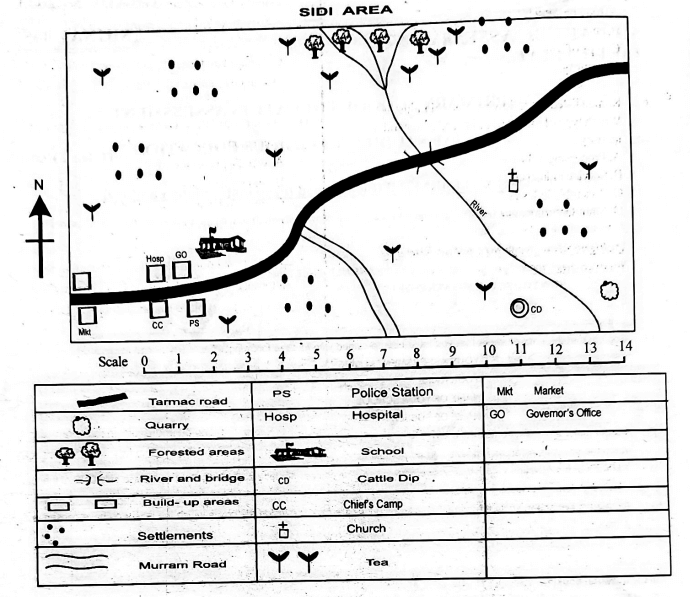
- The settlement pattern in Sidi area can be described as
- linear settlement
- dense settlement
- clustered settlement
- even settlement.
- The highest point in Sidi area is around the
- cattle dip
- shrubs
- forest
- chief's camp
- The flow of the river in Sidi area can be described as from
- North East to South
- North to South East
- South West to North
- North West to South East.
- The people in Sidi area are likely to be
- Hindus
- Muslims
- Pagans
- Christians.
- The location of the market in Sidi area was influenced by
- road passing by
- climate
- type of soil
- security.
- Kamau listed the following types of industries. Which type of industry is also called secondary industry?
- Processing industry
- Service industry
- Assembly industry
- Manufacturing industry.
Achieng drew the figure below. Use it to answer questions 7 to 8.
- The letters F and J respectively represent
- North East ans South West
- South West ans South East
- North West and South East
- North West and South West.
- Below are uses of the above figure. Which one is not? To
- show direction
- describe the flow of a river
- tell routes to a place
- show the highest point in a map.
- Grade 4 learners described physical features as shown below. Which of the following describes a plateau? A
- raised piece of land that is flat at the top
- form where water flows out of the ground from an underground source
- depression between two areas that are high or raised
- large lowland that is generally flat.
- Which one of the following is the main importance of the historic built environments?
- To attract tourist and earn foreign exchange.
- Provide employment opportunities.
- Remind and teach us about our culture.
- Create a sense of belonging.
- Which one of the following is a negative form of interaction? Through
- wedding ceremonies
- hunting activities
- raids and war
- religious activities.
- Henrick mentioned the following benefits of interdependence. Which one is not correct?
- People are able to live in harmony and unity.
- Promotes immorality.
- People get new ideas and knowledge.
- People are able to appreciate each other's culture.
- Belinda matched the industries in the county and their products. Which of the following is correctly matched?
Industry Product A. Creameries Cakes B. Pottery Cheese C. Jua kali Jikos D. Weaving Pots - A learner listed the benefits of trade in the county Which one is correct? It promotes
- bribery
- growth of slums
- pollution of the environment
- the agricultural sector.
- Below are economic activities in the county. Which one is the most common economic activity?
- Mining
- Saw milling
- Agriculture
- Basketry.
CREATIVE ARTS
- A teacher prompted learners to say any word that came in their minds. His aim was to give the words rhythmic names. Whose word was given the name ta-te?
- Lucy - Melon
- Janet-Gate
- Peris-Good morning
- Betty-Farm.
- Grade four learners discovered that a melody is composed by short and long sounds. Which of these is the shortest sound in Music?
- taa
- ta-te
- taa-aa
- taa-te-fe.
- Kiarie had four bottles. He wanted to produce sound with them. Which bottle produced the highest sound? The
- one half filled with water
- one fully filled by water
- empty plastic bottle
- empty metallic bottle.
- Musa sang a melody with these syllables:
mi fa so la. This is called _____________________ singing.- sideways
- upward
- downward.
- round.
- When we combine long and short sounds to form Music, we are creating
- pitch
- dynamics
- rhythm
- pace.
- Njue mentioned the elements of folk dance as shown below. Which one of them is false?
- Tempo
- Volume
- Space
- Energy.
- Participants were to carry musical instruments to accompany their folk songs performance. Who carried an instrument that is different from the others?
- Tom-whistle
- Steve-chivoti.
- Karen-coro
- Liz-isukuti
- Belinda decided to improvise the wind instrument shown below. 'Muturiru'
What is the best material for her to use?- Bamboo stick
- Wooden stick
- Plastic material
- Metal.
- Grade 4 learners were to sing the Kenyan National Anthem during assembly. On which day was it?
- Monday
- Tuesday
- Wednesday
- Thursday
- Grade 5 learners decided to take care of the instrument below.
How best can they do it?- Washing it while in use.
- Sharing with others who don't have.
- Keeping it under direct sunlight.
- Blowing it softly when using it.
A learner displayed the artwork below. Use it to answer questions 26 to 28.
- Which of the following types of lines is not used in the above artwork?
- Straight line
- Curved line
- Zigzag line
- Thick line.
- The learner decided to shade the artwork using the smudge technique. Which of the following materials is he not likely to use?
- Wax Crayons
- Coloured pencil
- Coloured Chalk
- Water colours.
- The above equipment is used to
- apply crayons
- make colours darker
- hold paint during painting
- make colours brighter.
Below is an artwork by a grade 5 learner. Use it to answer questions 29 to 31.
- Which of the following was not likely to have been used by the leaners to create the artwork above?
- Adhesive
- Pencil
- Needle
- Magazines.
- The above artwork was created using a technique called
- cutting and pasting
- collage
- montage
- sticking.
- When making the above artwork, one should consider the following factors except
- choose a particular theme
- ensure proper balance
- utilise the space well
- dry the artwork on a hot surface.
Grade 5 learners made the item below. Use it to answer questions 32 to 35.
- Which of the following materials is not used in making the above item?
- Nails
- Scissors
- Hammer
- Knife.
- The above artwork can be made using
- canvas
- leather
- nylon
- cotton fabric.
- Which of the following correctly matches the parts labeled F, K and P?
F K P A. Membrane
B. Laces
C. Laces
D. TinResonator
Membrane
Membrane
LacesLaces
Tin
Resonator
Membrane - The above item is played by
- tapping
- plucking
- blowing
- shaking
PART 2: Choose a section you have prepared for. Each section is 15 marks
CHRISTIAN RELIGIOUS EDUCATION
- According to the book of Jeremiah 29:11, what is God's purpose for our lives? To make us
- successful
- rich
- poor
- slaves.
- While reading the book of Genesis 1:26, 2:15, we learn that God gave responsibilities to human beings. Which of the following is not one of them? To
- name and take care of animals, fish and birds
- cultivate the land
- take care of the environment
- kill all the animals.
- Which of the following statements shows the way we can demonstrate good stewardship towards God's creation? By
- taking good care of the environment
- cutting down trees
- throwing garbage in the river
- killing wild animals.
- Learners wrote the following as factors that promote family unity. Which one does not promote unity?
- Sharing responsibilities at home.
- Reading the bible and praying together.
- Working together on chores and other projects.
- Arguing all the time.
- In Mathew 25: 14, we read about the parable of the talents. What lesson do we learn from it?
- God will punish us if we do not use our talents well.
- We should brag about our talents to others.
- We should laugh at those who do not have talents.
- We should not use our talents so that people do not know we have them.
- The Bible tells us about the fall of human beings. What lesson do we learn from it?
- We should obey God's word.
- We should not do anything we are told.
- God is merciless.
- The first humans were foolish.
- Which of the following is not a value we learn from the story of Noah and his sons?
- Honesty
- Empathy
- Obedience
- Carelessness.
- Grade 5 learners were discussing ways of showing respect to the elderly. Which of the following is not among them?
- Talking to them rudely.
- Helping with household chores.
- Obeying them.
- Offering them seats when there are no seats.
- We are taught that family unity is very important. This is because it
- promotes love and respect for one another
- brings chaos
- encourages theft
- brings about nepotism.
- Grade Spupils were learning about humility and pride. Which of the following is not a disadvantage of pride? It makes
- people selfish and self-centered
- a person feel superior and look down upon others
- a person succeed in life
- one be confident in themselves instead of in God.
- Wendy and her friends wrote the effects of child labour on a chart. Which one of the following is not one of the effect they wrote?
- Children become unhappy.
- Children become unhealthy.
- Children earn a lot of money.
- It affects the child's self-esteem.
- Grade 5 learners of were discussing the benefits of reading the Bible. Which of the following is not a benefit? Helps us to
- obey our elders
- know more about God
- know creation stories
- swear.
- Which of the following is not true about Peter and John? They
- told people about the Jesus who had risen from the dead
- healed a lame man in the name of Jesus Christ
- were arrested and put in jail
- earned a lot of money through healing people.
- Who among the following was not a member of the Jewish Council in which John and peter were brought in front of?
- Annas
- Jairus
- Alexander
- Caiaphas.
- Solving disputes is very important because it
- helps to maintain peace and harmony
- brings about pride
- helps one get rich quickly
- brings disagreements.
ISLAMIC RELIGIOUS EDUCATION
- Summar wrote the following prayers on a chart. Which one is NOT a sunnah prayer?
- Dhuha
- Asr
- Baadiya
- Qabliya.
- Grade five learners were asked to search for miracles of prophets on the Internet. Which one did they find out about Nabii Issa?
- Changed walking stick into a snake.
- Thrown into the fire but the fire did not burn him.
- Could understand the language of birds.
- Spoke at infancy.
- Two surahs known as muawidhatein are
- Naas and Maun
- Naas and Falaq
- Ikhlas and Naas
- Falaq and Fatiha.
- Saba'atul mathani must be recited in all prayers. Saba'atul mathani refers to
- Fatiha
- Falaq
- Fatih
- Baqara.
- The teacher narrated to grade 5 learners about the year of elephant. In the story, who wanted to destroy the Holy Kaaba?
- Abu jahal
- Abu Lahab
- Abraham
- Abraha
- In which surah is Ummu jamil mentioned?
- Maun
- Masad
- Ikhlas
- Tiyn.
- The prophet (saw) had the best character. Which one of the following was not among his characters?
- Untrustworthness
- Kindness
- Truthfulness
- Generosity.
- Grade 4 learners were discussing the manners of eating according to the sunnah of the prophet. Who gave the correct manners?
- Zubeir: Eating what is far from you
- Abdos: Eating hot-food.
- Kausy: Eating what is in front of you.
- Khubbayb: Eating with both hands.
- Complete the hadith on brushing our teeth. "Brushing of teeth is a means of purification of the mouths and pleasing
- Allah
- Angels
- parents
- iblis.
- Which one of the following pillars of Islam does not require physical fitness?
- Swalah
- Jum
- Zakat
- Hajj.
- Allah SWT sees everything. Which attribute of Allah describes Him as the all-seeing?
- AL samiu
- AL basir
- As salaam
- AL malik.
- Angels of Allah are created from
- nur
- clay
- fire
- smoke.
- Grade 5 learners were asked to write down the angels mentioned in the Holy Qur'an. How many prophets did they write down?
- 35.
- 15
- 20
- 25
- Angels have special duties. Which angel is incharge of rain?
- Mikail
- Malik
- Israfeel
- Raqib
- Who among the following prophets is referred to as ulul azm?
- Yunus
- Yusuf
- Yahya
- Musa.
MARKING SCHEME
- C
- C
- B
- D
- A
- C
- D
- D
- A
- A
- C
- B
- C
- D
- C
- A
- B
- D
- B
- C
- B
- D
- A
- A
- D
- A
- D
- C
- C
- A
- D
- A
- B
- C
- A
CRE
- A
- D
- A
- D
- A
- A
- D
- A
- A
- C
- C
- D
- D
- B
- A
IRE
- C
- D
- B
- A
- D
- B
- A
- C
- A
- C
- B
- A
- D
- A
- D
Creative Arts & Social Studies Questions - Grade 5 Opener Exams Term 2 2023 Set 2
ART AND CRAFT
- What are primary colours? They are
- colours obtained from nature.
- colours obtained from mixing secondary colours.
- colours found in natural state that not two colours can be added to obtain them.
- mixed secondary and tertiary colours.
- Which of the following is not a secondary colour?
- Red
- Blue
- Yellow
- Orange
- The main reason why we apply colour to a painting is to
- add value
- add tone
- add shape
- add light
- The main reason why we include wefts in basketry is to
- provide a framework for the basketry
- create beauty.
- create shape.
- make the basket weak and flexible.
- Strips of leather that can be used to join two or more pieces of leather are known as
- thongs
- hides
- mallets
- rafts
- The item below was modelled using clay. The technique used to make the item below is called
- pinch technique.
- slab technique.
- coil technique.
- thumb technique.
- The techniques used to finish the edges of a mat neatly after weaving is
- stitching and binding.
- plaiting and twining.
- binding and weaving.
- weaving and plaiting.
- The element that emphasizes on repetition is
- rhythm and movement
- balance
- proportion
- space
- Alice is mixing clay thoroughly by pressing it over and over again until moisture is evenly distributed. What she is doing is known as
- stamping
- incising
- embossing
- kneading
- What element shows smoothness and roughness of a surface?
- Texture
- Value
- Tone
- Colour
MUSIC
- The following are aspects of a folk song except
- message
- occasion
- instrumentation
- age
- The East African Community Anthem is sung during the following occasions except one. Which one is it?
- At the East African Community Meetings.
- During flag hoisting ceremonies.
- During birthday parties.
- During East African Community regional events.
- The following are parts of the body that we can easily use to create rhythm while singing. Which one is not?
- Mouth
- Hands
- Legs
- Ears
- How do we tune a drum?
- By hitting the drum.
- By plucking the leather strips.
- By sundrying the membrane.
- By tanning the laces.
- What do we call songs sung in praise of a country or leaders?
- Religious songs.
- Topical songs.
- Patriotic songs.
- Action songs.
- The following is a musical wind instrument.
It is played by- bowing
- plucking
- blowing
- rubbing
- Which of these combinations shows solfa notes in ascending order?
- doh, mi, reh
- doh, reh, mih
- mih, re, doh
- reh, doh, mih
- The following are values we learn from singing. Which one is not?
- Kindness
- Unity
- Greed
- Honesty
- The following are ways of handling descant recorder. Which one is not?
- Keep it where there is enough sunshine.
- Clean it before use.
- Do not drop it down to avoid breakage.
- Keep it in a dry place.
- Which of the following is a safety measure that should be observed when dancing?
- Use sharp props.
- Dance when you are very close to each other.
- Dance when wearing heavy metallic ornaments.
- Avoid hitting each other while dancing
SOCIAL STUDIES

Study the map of Kaka area and answer questions 21-25
- What is the title of the area represented in the map?
- Kaka area
- Pata area
- Koko area
- Kiboko area
- The main cash crop grown in the area is
- maize
- tea
- coffee
- rice
- Many people in the area are
- Christians
- Muslims
- Hindus
- Pagans
- The population distribution pattern in the area is
- clustered
- sparse
- linear
- dense
- The forest in the area is found in which direction of the map?
- South
- North
- East
- South
- Which country boarders Kenya'to the East?
- Somalia
- Uganda
- Tanzania
- Ethiopia
- Grade 5 learners were asked by their teacher to name the elements of a map. Who gave a wrong response?
- Mweru - frame
- Mwai - scale
- Onyango - key
- Kiprono - colour
- Which of the following is a cardinal point of a compass?
- North West
- North East
- South West
- East
- Grade 5 learners went for an educational trip to Mombasa. They saw one of the historical built environments. This historical built environment was
- Indian Ocean
- the Coastal beaches
- Fort Jesus
- Dedan Kimathi statue
- Which one of the following is not a drainage feature?
- River
- Lake
- Ocean
- Plateau
- Which among the following is not a Bantu speaking community?
- Maasai
- Agikuyu
- Akamba
- Abaluhya
- Traditional methods of instruction in traditional education include all the following except
- use of riddles
- use of proverbs
- use of stones
- use of books
- Which one of the following is not a function of the head teacher in a school?
- Keeps school records.
- Keeps record of money.
- Admits new pupils.
- Prepares the school timetable.
Use the map below to answer questions 34 and 35.
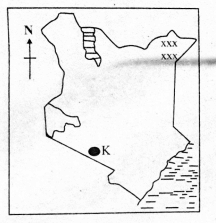
- The lake marked K is known as
- Lake Victoria
- Lake Turkana
- Lake Nakuru
- Lake Magadi
- The main language group that is found in the region marked xxx is
- Bantus
- Nilotes
- Cushites
- Europeans
C.R.E
- According to Genesis 3:1-13, Adam and Eve sinned against God when they
- hid themselves from God
- ate the forbidden fruit
- spoke to the serpent
- separated from each other
- Human beings are special in God's creation because
- they were last to be created.
- they look like God.
- they can speak.
- they were created in the image and likeness of God.
- Which one of the following is not a gift of the Holy spirit?
- Healing
- Wisdom
- Peace
- Working miracles
- The early believers did the following except
- shared meals together
- shared their belongings with each other
- fellowshipped together
- persecuted others together
- The lesson Christians learn from the parable of the three servants is that
- we should use our God given abilities wisely
- we should use our abilities for our own use
- we should not help those who are not our friends
- we should use our abilities to serve family members only
- The Bible was written by
- God Himself
- the Holy spirit
- people inspired by the Holy spirit
- different people from different parts of the world.
- When Moses was called by God he was living in the land of
- Midian
- Egypt
- Canaan
- Judea
- .......Your sins are forgiven. "Get up and walk."
During which miracle did Jesus say these words?- Healing of the blind man.
- Changing water into wine.
- Raising of Lazarus.
- Healing of the paralysed man.
- Complete the beatitude below.
..."Happy are the merciful for God will...- be merciful to them
- comfort them
- forgive them
- bless them
- Three of the following are rites of passage in Traditional African Societies. Which one is not?
- Birth
- Baptism
- Marriage
- Death
- Which one of the following parables of Jesus teaches Christians that they should be persistent in prayer?
- Friend at midnight
- The pharisee and the tax collector
- The lost coin
- The mustard seed
- Who among the following healed the mother-in-law of Simon Peter?
- Peter
- Paul
- Jesus
- James
- When king Solomon wanted to rule the Israelites well, he asked God for
- wisdom
- wealth.
- good health
- knowledge
- In which town did Jesus meet Zaccheaus?
- Cana
- Jericho
- Jerusalem
- Bethany
- While playing in the field, you find a one hundred shillings note. As a Christian, what action will you take?
- Leave it there for the owner to find it
- Take it there for your own use
- give it to the head teacher to find the owner.
I.R.E
- Salim a grade six learner is planning to perform Swalatul Isha. Which of the following will be the first thing for him to do?
- Perform wudhu
- Face Qiblah
- Say the Shahada
- Put on a clean clothe
- Which surah of the Quran helps a Muslim to understand the oneness of Allah (S.W.T)?
- Al-Falaq
- An Naas
- Al-Ikhlas
- Al- Maun
- How many verses are there in surah Al-Fatiha?
- Six
- Seven
- Eight
- Ten
- Abdul Jabal was discussing with his friends about the revealed scriptures. Which of these scriptures was revealed to prophet Daud (A.S)?
- Taurat
- Suhuf
- Qur'an
- Zabur
- "Pray and sacrifice to your Lord. "This quotation is a verse from surah
- Maun
- Ikhlas
- Falaq
- Kauthar
- You have a friend who does not wear clothes that cover her nakedness. Which of the following will not be a good advice for you to give her?
- Respect yourself
- Be a role model
- You look nice
- Follow the Quran's hadith
- What should a Muslim say after eating?
- Maashallah
- Alhamdulillahi
- Bismillahi
- Subhanallah
- Salma a grade five learner likes being clean and brushes her teeth oftenly. Which one of the following times is Salma not required to brush her teeth?
- In the morning
- Before laughing
- Before sleeping
- After eating
- Allah (S.W.T) is known as the king of kings. This is the same as
- Al-Malik
- Al-Razzak
- Al-Khaaliq
- Al-Wadud
- While researching using a digital device on the prophets, Kheri came across prophets who are known as Ulul Azmi. Who among the following is not one of Ulul Azmi prophets?
- Musa
- Ibrahim
- Issa
- Adam
- What is the meaning of the term twahara?
- Wudhu
- Istinjai
- Cleanliness
- Uncleanliness
- While playing in the school playground, Ismail a grade five learner was licked by a dog. Which type of najasaat did he find himself in?
- Mutawasita
- Mughalladha
- Mukhafafa
- Hadath Akbar
- The nakedness of a Muslim man is between the knees and the
- navel
- head
- stomach
- feet
- Three of the following are duties of a child to his parents. Which of them is not?
- Caring for them
- Praying for them
- Helping them with work
- Quarelling them
- Who was the foster mother of prophet Muhammad (S.A.W)?
- Halima
- Amina
- Hawa
- Maryam
Social Studies, Creative Arts & Religious Studies Questions and Answers - Grade 4 Mid Term 2 Exam 2023 Set 3
PART A : SOCIAL STUDIES
Study the map of Kira Area and answer questions 1 to 5

- The direction of lake Kira from the hospital is
- West
- East
- South
- North.
- River Kira drains its water into the
- Forest
- cattle dip
- Swamp
- Lake.
- Learners from Kira school named the physical features found in the area. Which one is not part of them?
- Swamp
- Lake
- Ocean
- River.
- The cattle dip is used for
- planting crops
- watering animals
- killing pests
- treating animals.
- Which of the following crops is grown for sale in Kira area?
- Coffee
- Tea
- Sisal
- Cotton.
- John drew a compass in his book. What name is given to the point between North and West?
- North East
- South West
- South East
- North West.
- Jophiel's uncle is a governor. He heads a
- county
- country
- sub-county
- town.
- Jerrica wore a heavy cloth while going to school. Which season was the area experiencing?
- Dry season
- Warm season
- Rainy season
- Hot season.
- Grade four learners were asked by their teacher to name physical features found around their school. Which one of the following did the learners not mention?
- Roads
- Mountains
- Hills
- Rivers.
- Below is a physical feature in an area. The feature shown is a
- Mountain
- ocean
- lake
- river.
The picture below shows an aspect of traditional culture. Use it to answer questions 11-15.
- The aspect of culture shown is called
- Enyumba
- Manyatta
- Moran house
- Boma.
- The aspect of culture shown belongs to which community?
- Luo
- Maasai
- Turkana
- Rendile.
- The structure above is mostly built by
- children
- men
- adults
- women
- Three of the following are sources of water. Which one is not?
- Lakes
- Rivers
- Hills
- Oceans.
- Which one of the following is a resource found in the county?
- Clouds
- Land
- Cars
- House
PART B: MUSIC
- Which of the following musical instruments is played the same way as the one shown below?
- Marimba
- Kayamba
- Flute
- Drums.
- During a Music lesson, a teacher sang a certain song. Learners listened and sang along as they touched different parts of their bodies. The song is likely to be ______________________ song.
- a happy
- a topical
- an action
- a patriotic.
- Teacher Mercy asked Grade 4 learners to present folk songs. Kyle presented a song which he accompanied with a slasher. Which occasion
is the song sung?- Birthday
- Wedding
- Funeral.
- Work.
- Maggy has been assigned the part of singing Soprano while Ben will sing bass. If they will sing together the same song, we shall say they are singing in
- harmony
- collaboration
- unison
- turns.
- If all the children at school present a song together, such performance is called
- multiple
- solo
- choral
- group.
- Belinda was asked to identify on the Kenyan flag the colour that represents vegetation. Which colour should she choose?
- White
- Black
- Red
- Green.
- Who among the following pupils did not misbehave when the Kenyan National Anthem was being sang?
- Pat- Stood at ease.
- Carol-Sang loudly on top of her voice.
- Zack-Sang faster than the rest.
- Kim-Stood at attention.
- When a certain song was being sung, learners were responding in different ways. Which of the following was a negative response?
- Nodding.
- Shouting
- Clapping.
- Stamping
- Learners improvised some musical instruments to use during devotion. Which one of the following produced the loudest sound?
- Plastic bottles.
- Wooden materials.
- Rubber shoes.
- Metalic tins.
- While singing the Kenya National Anthem, Musa kept silent when he reached the second line of the second verse. What should he sing?
- Tufanye sote bidii.
- Natukae na undugu, amani na uhuru.
- Ee ndio wajibu wetu.
- Ilete baraka kwetu
PART C: ART AND CRAFT
Tony made the artwork below. Use it to answer questions 26 to 29.
- Which of the following is not an embellishment that can be used on the above artwork?
- Beads
- Sand
- Broken glass
- Piece of cloth
- The artwork above was likely to have been created using the
- coiling technique
- kneading technique
- pinching technique
- cutting technique.
- The above artwork can be used for the following purposes except
- cooking
- displaying flowers
- putting keys
- putting stationery.
- Which of the following decoration techniques has been used in the above artwork?
- Applique
- Embedding
- Incising
- Scratching.
- Which of the following is a natural material that can be used to make the above artwork?
- Plasticine
- Clay
- Rubber
- Leather.
Keli displayed the fabric below. Use it to answer questions 31 to 33.
- Which of the following techniques was used to decorate the fabric above?
- Montage
- Collage
- Applique
- Sewing.
- The outline of the decoration above can be described as
- Wavy line
- Zigzag line
- Broken line
- Spiral line.
- Angela listed the following tools and materials. Which of them cannot be used to decorate the above fabric?
- Thimble
- Needle
- Adhesives
- Pen.
- A grade 4 learner listed the following tools. Which of the following tools cannot be used in drawing?
- Sharp tools
- Pencil
- Charcoal
- Pastel.
The figure below was drawn by a grade 4 pupil.
- The picture above is called a
- decoration
- colour wheel
- pyramid
- triangle.
PART 2: Choose a section you have prepared for. Each section is 15 marks.
CHRISTIAN RELIGIOUS EDUCATION
- Naaman, a man who was healed by prophet Elisha was suffering from
- blindness
- leprosy
- possession
- diabetes.
- Which of the kings of Israel ordered the people to bow down and worship idols?
- King Nebuchadnezar
- King Ahab
- King Saul
- King David.
- Shadrack, Meshack and Abednego are the Hebrews who refused to worship idols. What happened to them? They were
- thrown into a burning furnace
- sent away from the city
- beheaded
- forgiven.
- Which town was Elisha in when he cursed boys who made fun of him?
- Jericho
- Bethel
- Nineveh
- Nazareth.
- Who was the king of Israel when Jesus was born?
- King David
- King Herod
- King Ahab
- King Saul.
- The three wise men who came to visit the new born Jesus came from which direction?
- East
- West
- South
- North.
- Why were the parents of Jesus in Bethlehem. when he was born?
- They had gone there to be counted.
- They had gone to buy items there.
- They were visiting family members.
- They lived there.
- The stories that Jesus used to teach people are called
- narratives
- parables
- fables
- legends.
- From the story of the good Samaritan, what lesson do we learn?
- We should ignore those who are not from our tribe.
- We should help everyone regardless of who they are.
- Jews were selfish.
- Priests are not supposed to touch sinners.
- How many people did Jesus feed with five loaves and two fish?
- 5000
- 2000
- 12
- 700
- What is the name of the man whose daughter was healed by Jesus?
- Andrew
- James
- Naaman
- Jairus.
- Why did Ananias and Saphira die after they sold their land? Because they
- cheated God
- were sick
- killed Jesus
- were poisoned.
- Which of the following is true?
- Jesus cursed the forty two boys.
- Moses walked on water.
- Jonah was swallowed by a big fish.
- Elisha fed five thousand people
- Which one of the following is not a way of thanking God?
- Singing
- Offering sacrifices
- Drinking alcohol
- Praying,
- What is the parable which Jesus used to teach about forgiveness? The parable of the'
- unforgiving servant.
- good Samaritan
- talents
- sower.
ISLAMIC RELIGIOUS EDUCATION
- The Aya below means;
- in the name of Allah, the most Gracious the Most Merciful
- master of the day of judgement
- the most Gracious, the Most Merciful
- you alone do we vrship and you alone do we ask for help.
- The animal below is slaughtered on which occasion?
- Eidul fitr
- Eidul adh-ha
- Miladul nabii
- Christmas.
- How many verses are found in Suratul Kaafirun?
- 5
- 4
- 6
- 7
- The symbol below is metnioned in Surah
- Maun
- Lahab
- Fatiha
- Asr.
- Which pillar of islam is performed around the house below?
- Saum
- Hajj
- Shahada
- Zakah.
- The man who leads prayers in the house above is known as
- Priest
- Sheikh
- Imam
- Maalim.
- Which Prophet of Allah was given the book below?
- Ibrahim
- Musa
- Muhammad
- Issa
- The uncle of the prophet who took care of him is known as
- Abi Twalib
- Abdul Mutwalib
- Ali
- Abu Lahab.
- Which one of the following is a good character?
- Shouting at young kids.
- Greeting the elderly.
- Throwing dirt on the road..
- Laughing at the disabled.
- The food given to the poor before Eidul Fitr prayers is known as
- Zakatul maal
- Sadaqa
- Zakatul fitr
- Iftaar.
- On which day do we say this dua,
"Taqaballahu minnaa wa minkum"- Eid day
- Friday
- Aqiqa day
- Burial day.
- How many children did the prophet saw have?
- 4
- 5
- 8
- 7
- A good Muslim prays at least _____________________________________________________rakaa in a day.
- 5
- 7
- 17
- 50
- It is sunnah to say. _______________________________ before eating.
- Bismillah
- Alhamdulillah
- Subhanallah
- Inshaallah.
- Grade four learners were performing swalah in their school mosque. Their swalah ended with
- Bismillah
- Salaam
- Tashahud
- Takbir.
MARKING SCHEME
SOCIAL STUDIES
- B
- C
- C
- D
- B
- D
- B
- C
- A
- D
- B
- B
- D
- C
- B
- B
- C
- D
- A
- C
- D
- D
- B
- D
- A
- D
- C
- A
- B
- B
- C
- B
- D
- A
- B
C.R.E
- B
- A
- A
- B
- B
- A
- A
- B
- B
- A
- D
- A
- C
- C
- A
I.R.E
- A
- B
- C
- B
- B
- C
- D
- A
- B
- C
- A
- D
- C
- A
- B


